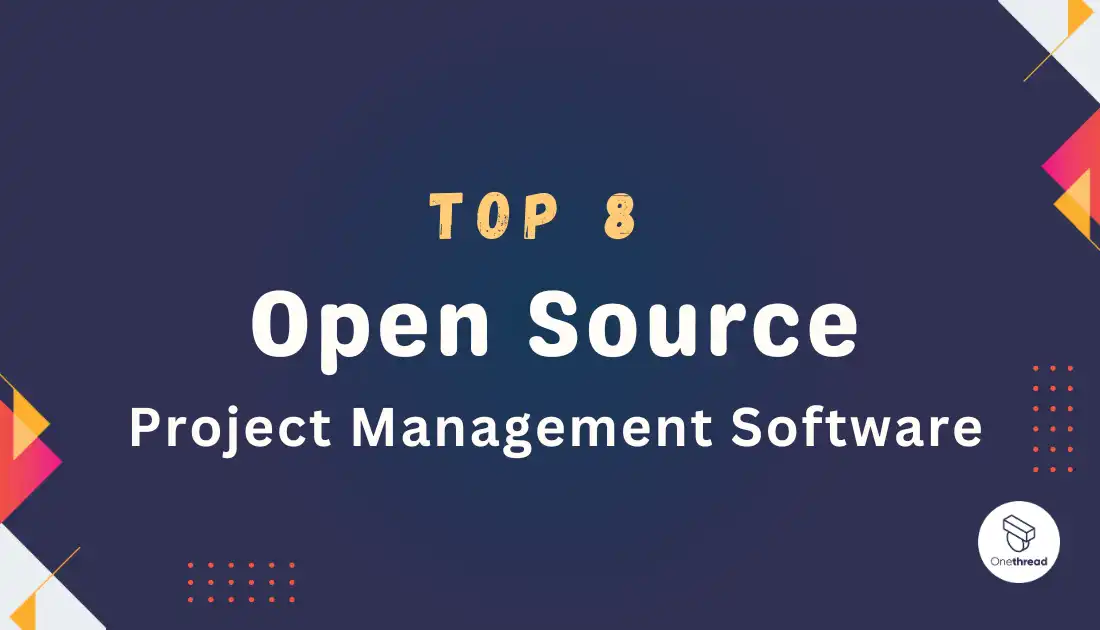Struggling with clunky open-source project tools lacking features or flexibility for your needs? Between complex setups, limited visibility, and tricky customization, common platforms often introduce more headaches than help. What if there was an easier way?
This guide spotlights the top all-in-one solutions that simplify project collaboration for versatile teams through intuitive interfaces and seamless integrations with other platforms you rely on daily.
Quick List of The Best 8 Open Source Project Management Software
- Onethread: Best for non-technical users prioritizing simplicity. Not an open source but has a Free Forever plan with lightning-fast customer support.
- OpenProject: Best for large teams needing enterprise-scale configurability.
- ProjectLibre: Best for migrating from Microsoft Project.
- Taiga: Best for agile teams wanting customizable Kanban boards.
- GanttProject: Best for advanced Gantt chart visuals and scheduling.
- Kanboard: Best for basic Kanban workflow visualization.
- Orangescrum: Best for configuration control and financial oversight.
- Wekan: Best for fast and lightweight Kanban adoption.
As you’ve got the initial idea of the best open-source project management software, let’s understand some basic fundamentals. However, if you want to get to the open-source software list, you can jump from here.
Our reviewers evaluate software independently. Clicks may earn a commission, which supports testing. Learn how we stay transparent & our review methodology.
What is Open Source Project Management Software?
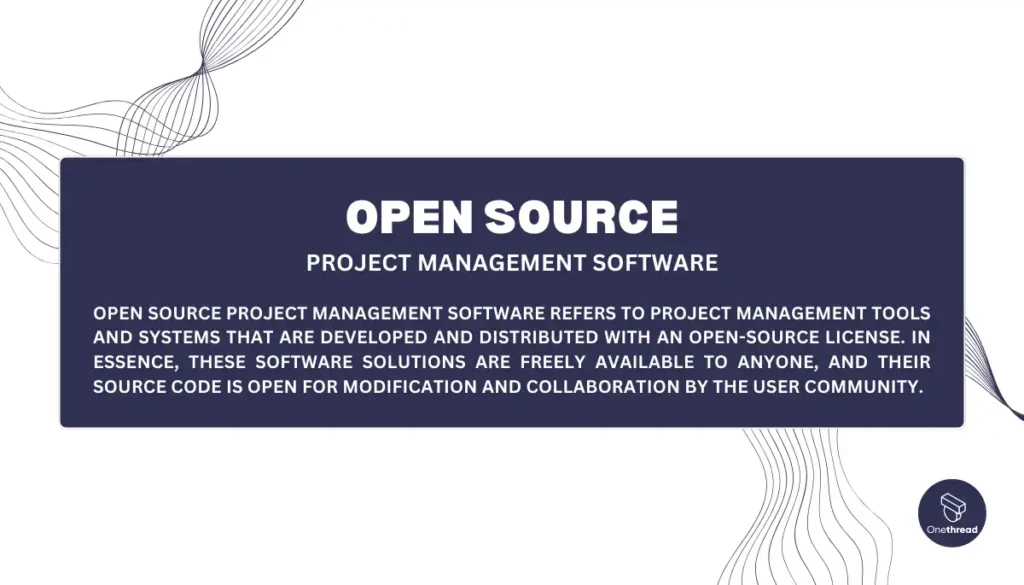
Open Source Project Management Software refers to project management tools and systems that are developed and distributed with an open-source license. In essence, these software solutions are freely available to anyone, and their source code is open for modification and collaboration by the user community.
This open approach allows individuals and organizations to customize the software to suit their specific project management needs, making it a cost-effective and highly flexible option.
Open-source project management software often includes features such as task tracking, collaboration tools, Gantt charts, and reporting capabilities, making it a valuable resource for teams and businesses seeking efficient ways to plan, execute, and monitor projects while maintaining full control over the software’s functionality and security.
How Open Source Project Management Software Can Help Your Business?
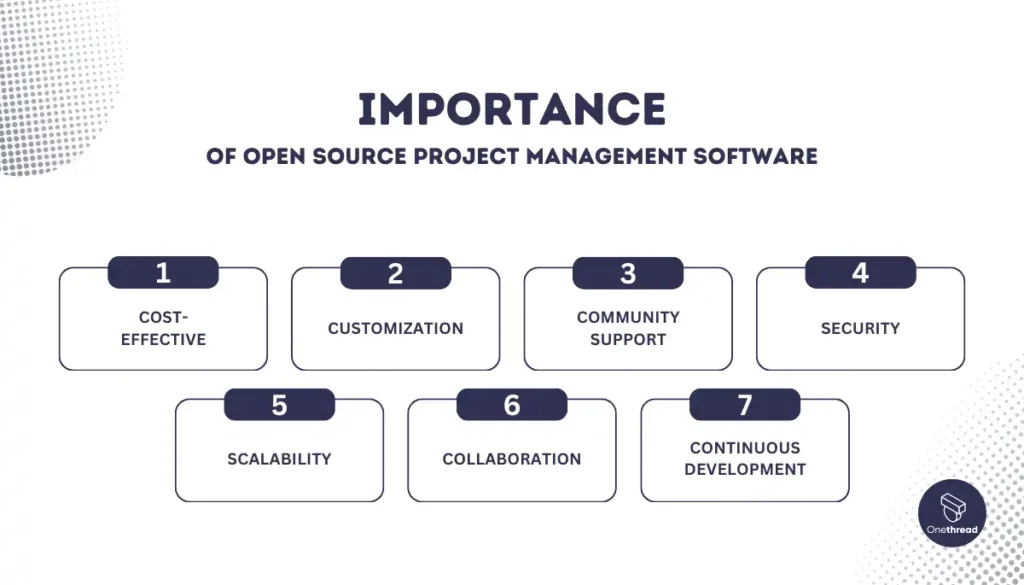
Open Source Project Management Software offers a multitude of advantages for individuals and businesses alike. Here’s a quick rundown:
- Cost-Effective: It’s budget-friendly as there are no licensing fees or subscription costs, making it ideal for small businesses and startups.
- Customization: Tailor the software to match your unique project management requirements, ensuring it aligns perfectly with your business processes.
- Community Support: Benefit from a global community of developers and users who contribute to ongoing improvements and provide support.
- Security: Transparency in source code allows for rigorous security checks, reducing vulnerabilities and enhancing data protection.
- Scalability: Grow your business without worrying about scaling costs; open-source software can adapt to your needs.
- Collaboration: Foster teamwork with collaborative features, ensuring everyone is on the same page, no matter where they are.
- Continuous Development: Regular updates and new features keep your project management software up-to-date and competitive.
Top 8 Open Source Project Management Software
Here’s a detailed comparison chart on Open Source Project Management Software for you to get a quick look at:
Softwares | Software Orientation | Setup & Configuration | Complexity & User-Friendliness | Cross-Project Features | Limited Features (Free) |
 | Not software-focused, versatile for various projects | Simple and user-friendly setup | Highly intuitive interface, easy to learn | Limited, no dedicated cross-project dashboards | Most essential features included in free plan |
 | All project types, includes software development features | Can be complex, requires some technical knowledge | Can have a steep learning curve, technical knowledge helpful | Extensive cross-project capabilities, multi-project views and dashboards | Most essential features included in free plan |
 | Software development focus, but compatible with other project types | Easy for experienced users, may require configuration help for beginners | Familiar interface for familiar users, but can be complex for beginners | Limited, mainly individual project focus | All features included in free version |
 | Agile-focused, primarily software development | Relatively easy setup, but some advanced features require technical skills | Intuitive for agile teams, requires some understanding of Scrum/Kanban | No dedicated cross-project features | Most essential features included in free plan |
 | Waterfall and Gantt chart focus, diverse project types | Simple desktop app, GanttProject Cloud requires some configuration | Steeper learning curve for advanced features, mostly Gantt charts | Single project focus, Gantt charts for individual projects | All features included in free version |
 | Not software-focused, Kanban board for any project type | Easy setup, self-hosting requires technical expertise | Simple and lightweight Kanban interface, minimal learning curve | Not designed for cross-project management | All features included in free version |
 | All project types, including non-software | Straightforward setup, on-premise requires technical knowledge | Can be complex for large teams, but intuitive for smaller teams | Multi-project views and dashboards available | Most essential features included in free plan |
 | Not software-focused, Kanban board for any project type | Very simple and quick setup | Simple and intuitive Kanban interface, minimal learning curve | No dedicated cross-project features | All features included in free version |
Let’s discover the top 8 open source project management software options that offer cost-effective and customizable solutions for efficient project management and collaboration.
1. Onethread
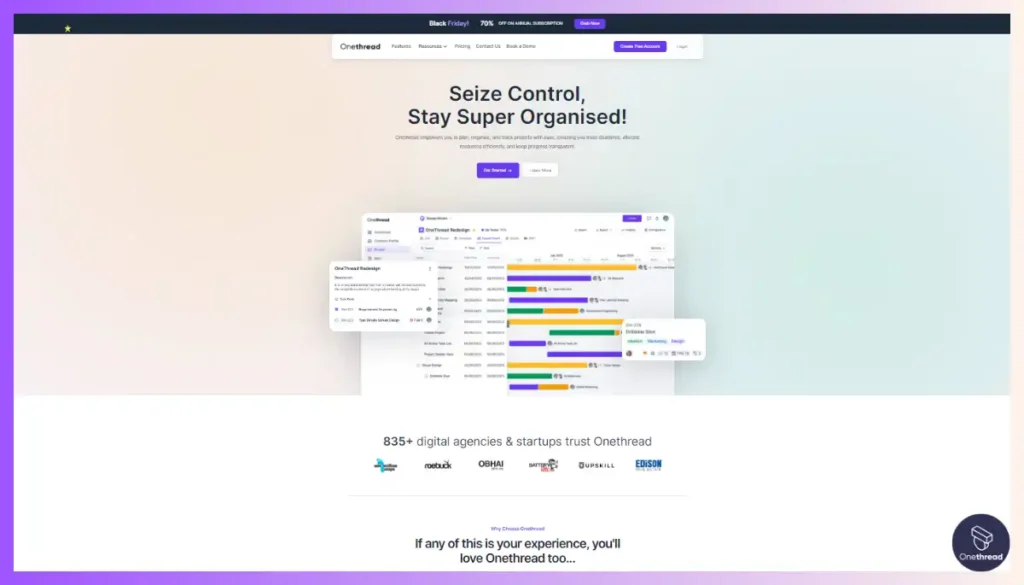
Onethread is not open source software, however, it offers one of the most user-friendly and full-featured solutions for project management needs.
Onethread impresses its users with its versatility to support different types of projects beyond just software development. It simplifies the setup process considerably compared to some complex open-source alternatives. The interface is clean, simple, and easy-to-understand as well.
Onethread combines all core project management tools like task tracking, documentation, and team communication in a single affordable package. This eliminates the need for multiple apps. It also provides more storage than competitors. With only 3 pricing tiers, including 1 free offering, it makes billing simple. The scalability also enables smooth integrations with other platforms.
Where Onethread falls slightly short is it lacks a self-hosted option for maximum data privacy and control. When compared to OpenProject, it does not have advanced add-ons for specific industries or premium-tier enterprise support.
However, Onethread’s positioning mainly targets small teams and simplicity-focused users where it shines over more complex solutions. Considering most open-source project management software falls short in addressing user challenges around complexity, Onethread solves this effectively with its simplified approach.
Key Features of Onethread
Onethread boasts an impressive array of features that streamline project management and enhance collaboration. Here are some of its key features:
Unlimited Free Plan
Onethread offers a permanently free version with uncapped projects, tasks, and teams – crucial for groups (up to 10 users) with limited budgets seeking to avoid paid software.
Intuitive Task Management
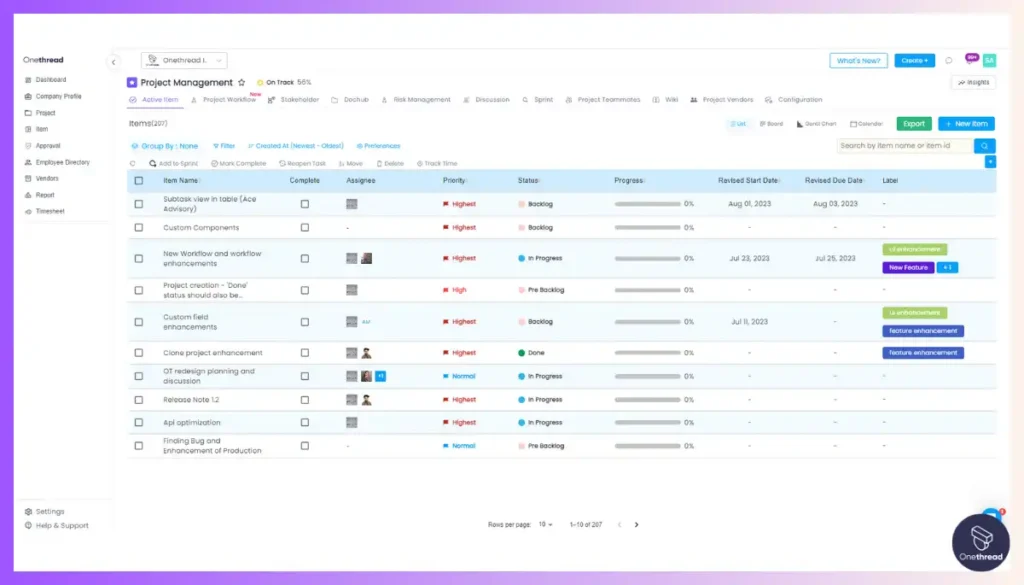
Onethread enables easy task assigning, deadlines, progress tracking, and delegation through simple interfaces focused on usability over complexity – solving common adoption barriers.
Real-Time Team Communication
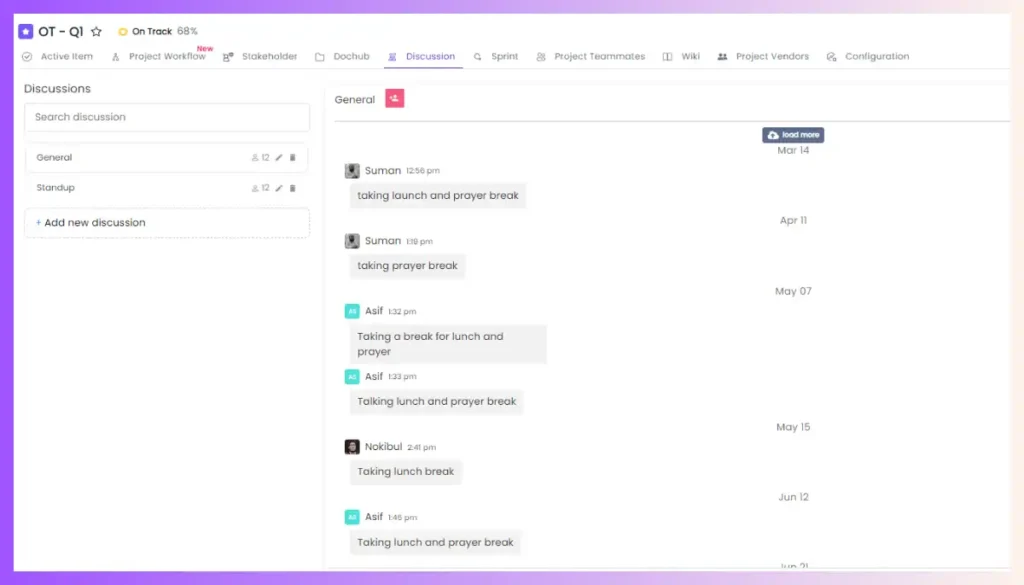
Instead of siloed community forums common in open-source tools, Onethread builds seamless messaging within the platform for direct collaboration and support.
Customizable Dashboards
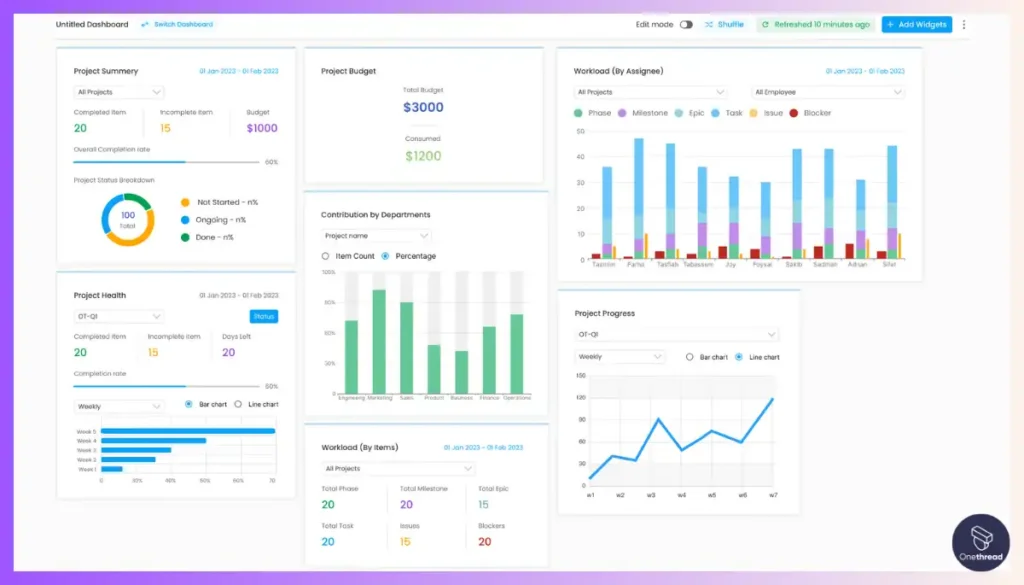
Users can tailor personal data views with custom widgets suited to their responsibilities and update needs without relying on broad defaults.
Lightning-Fast Support
Rather than waiting on voluntary forums common for assistance with open source platforms, Onethread offers premium-tier live support with sub-24-hour response times even on free plans.
Some other essential features of Onethread are-
Interactive Workflow & Schedule Management:
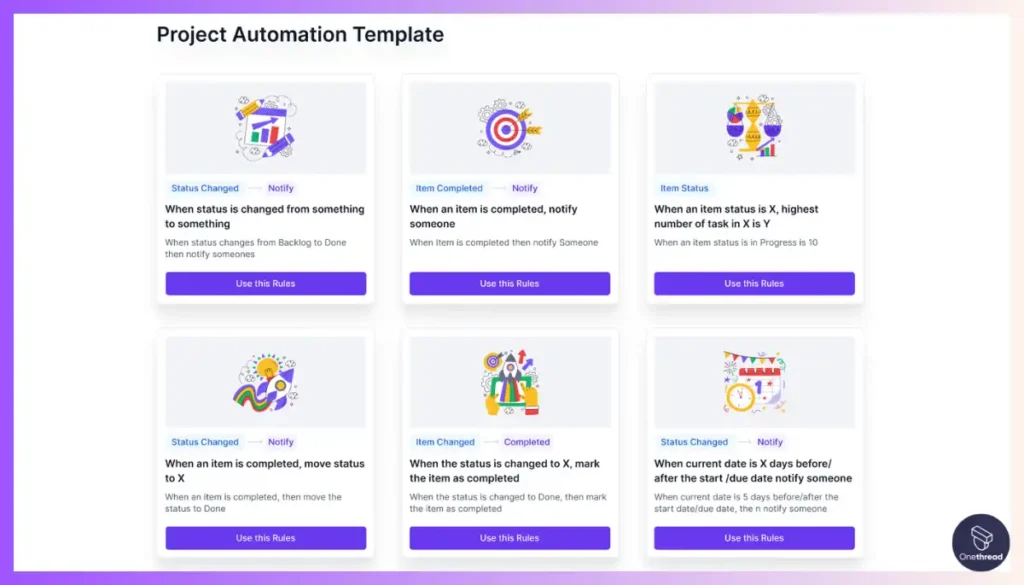
Onethread excels in providing interactive tools for efficient workflow and schedule management.
- Visual Workflow Planning: Plan project workflows visually, making it easy to identify bottlenecks and optimize processes.
- Task Dependencies: Set task dependencies, ensuring that tasks are completed in the correct sequence for project success.
- Resource Allocation: Assign team members to tasks, optimizing resource utilization.
Kanban Board:
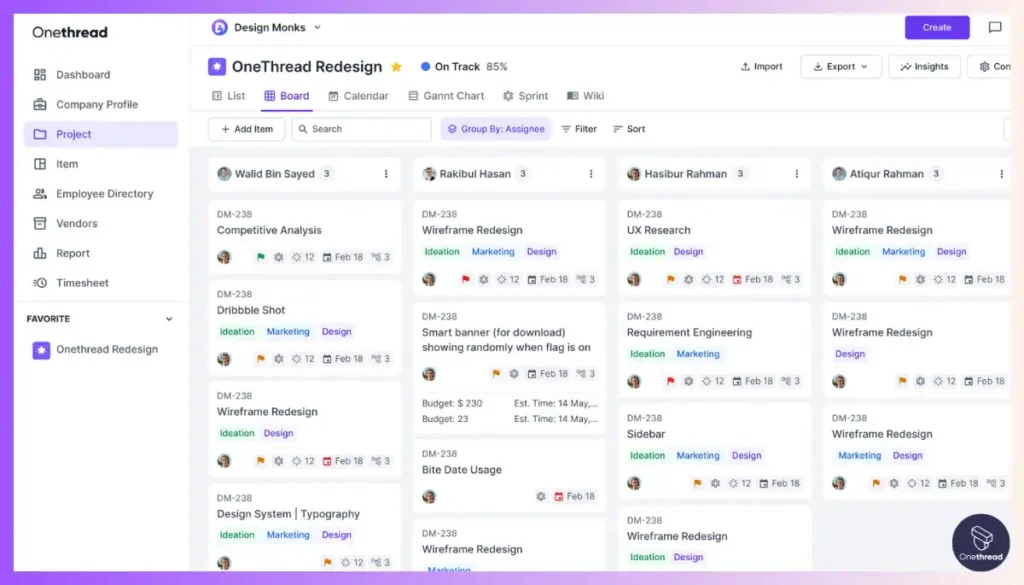
Onethread enhances agility with an intuitive Kanban board for visual task management.
- Task Visualization: Easily view and prioritize tasks using Kanban boards.
- Drag-and-drop Functionality: Swiftly move tasks through various stages of completion.
- Work-in-progress Limits: Set limits on tasks in progress to optimize workflow.
- Customizable Columns: Adapt the Kanban board to match your workflow stages.
Project Hierarchy:
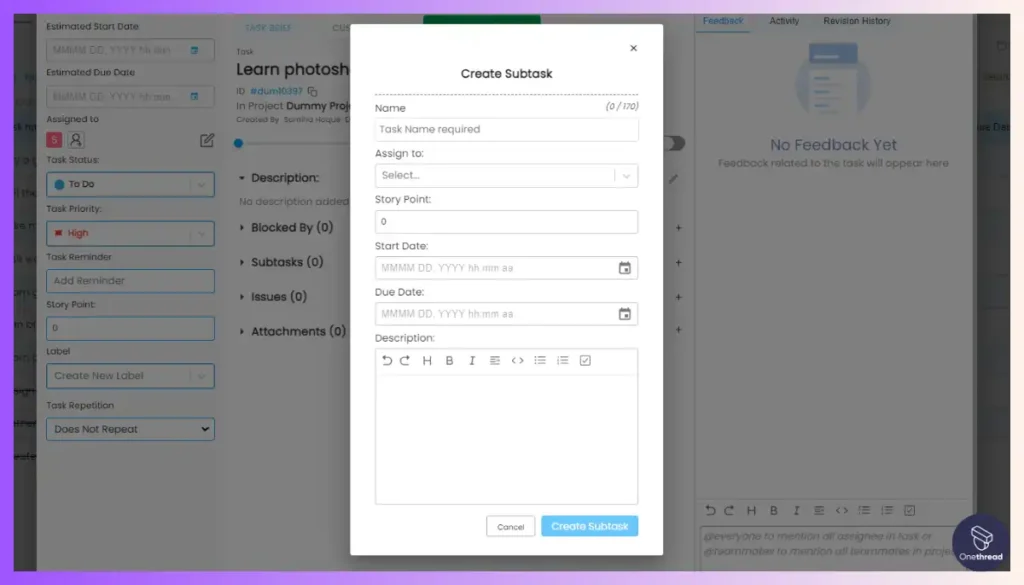
Onethread offers a hierarchical structure for organizing and managing complex projects.
- Subtask Management: Easily break down project tasks into subtasks for detailed planning.
- Project Dependencies: Establish dependencies between projects, ensuring seamless coordination.
Multi-project Views:
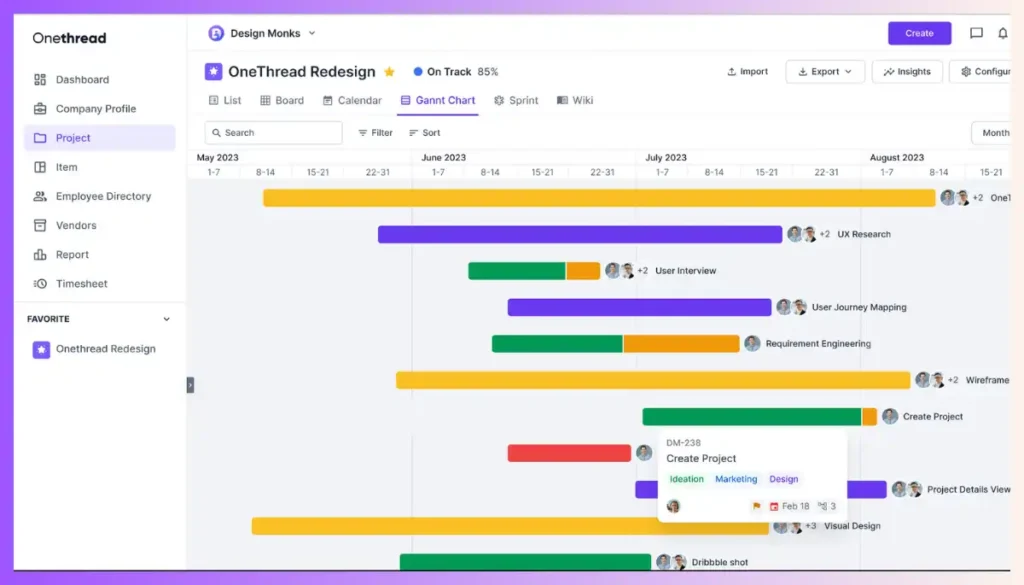
Onethread empowers users with the ability to manage multiple projects simultaneously. With Onethread, you can efficiently allocate resources across multiple projects to prevent overextension.
Best Use Cases of Onethread
Here are 5 best use cases for Onethread as an open-source project management alternative:
Small Businesses: Teams of under 200 people needing an affordable, easy-to-implement solution for occasional remote collaborators without overcomplicating things.
Non-Technical Teams: Staff across departments like marketing, HR, and operations seeking task management without software development orientation or coding requirements to access features.
Startups: Early-stage ventures wanting PM software providing complete transparency into workloads for agile planning as needs rapidly shift.
Family Teams: Relatives collaborating on personal projects who need shared task visibility but not full-scope enterprise tools with excessive permissions and controls.
Light Users: Solopreneurs, freelancers, and 2-3 person teams needing integrated PM without the complexities of tools serving 500+ people simultaneously.
Pros of Using Onethread:
- Free Forever Plan: The free forever plan allows unlimited organizations, projects, tasks, and storage with core features to manage real work, enabling teams of any size to realize their potential without paying a dime.
- Convenience: Onethread combines every essential feature like tasks, docs, and communication into one seamlessly integrated hub, avoiding the complexity of juggling multiple apps.
- Simplicity: The interface is thoughtfully designed for simplicity and ease of use with a gentle learning curve, especially useful for non-technical teams.
- Cost Savings: The affordable all-in-one pricing means no paying for multiple piecemeal solutions, providing complete project management at a fraction of the cost.
- Customizability: Onethread allows adaptability to your unique workflow needs, with the ability to customize statuses, fields, rules, forms, and permissions.
- Assurance: The service stays relentlessly focused on fulfillment reliability, from servers and security to responsive support, ensuring dependable access.
Pricing plans and options

Onethread offers three pricing plans to cater to a wide range of users. These plans include:
Basic: Free forever (Up to 10 users)
- Unlimited organizations, projects, tasks
- Unlimited discussion rooms
- 15GB file storage
- Notice board
- Dashboards
- Best for small teams
Growth: $3 per user/month (Annual billing)
- Up to 50 users
- Everything in Basic
- Task and project export
- Standardized reporting
- Ideal for growing teams
Scale: $5 per user/month (Annual billing)
- Up to 200 users
- Everything in Growth
- Early access to new features
- Custom workflow
- Advanced reporting
- Custom roles and permissions
- Upcoming features like risk management, RAID log, budgeting
- For large teams and enterprises
Onethread also offers a 14-day free trial for Growth and Scale plans.
What Users Say About Onethread?
Review on G2: 4.7 out of 5
“Onethread is super intuitive, easy to set up, and transitions into our everyday SOP. The platform is feature-rich without having a steep learning curve.
My favorite feature I’ve found so far is the ability to have multi-organization collaboration.
For the price, this is an awesome piece of kit!”- Finlay W.
Review on Product Hunt: 5 out of 5
“The onboarding process is much easier. It also helps me track my productivity. I am currently using the free trial. As far as I have used it, it has become a part of my life now. I love it. Thank you for the lovely tool. Best of luck.”- Anisul Islam
Why Should You Choose Onethread for Your Project Management Needs?
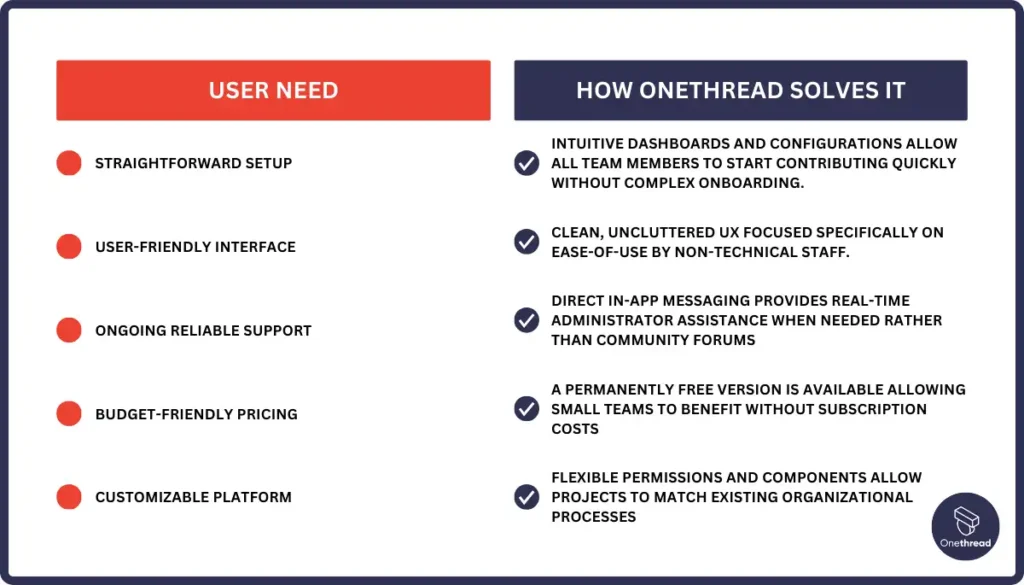
Onethread makes project collaboration incredibly simple and accessible, overcoming many challenges users face with traditional open-source platforms.
By directly building on user frustrations with existing open-source tools, Onethread tailors the project management experience around accessibility specifically for non-technical teams.
Try Onethread
Experience Onethread full potential, with all its features unlocked. Sign up now to start your 14-day free trial!
2. OpenProject
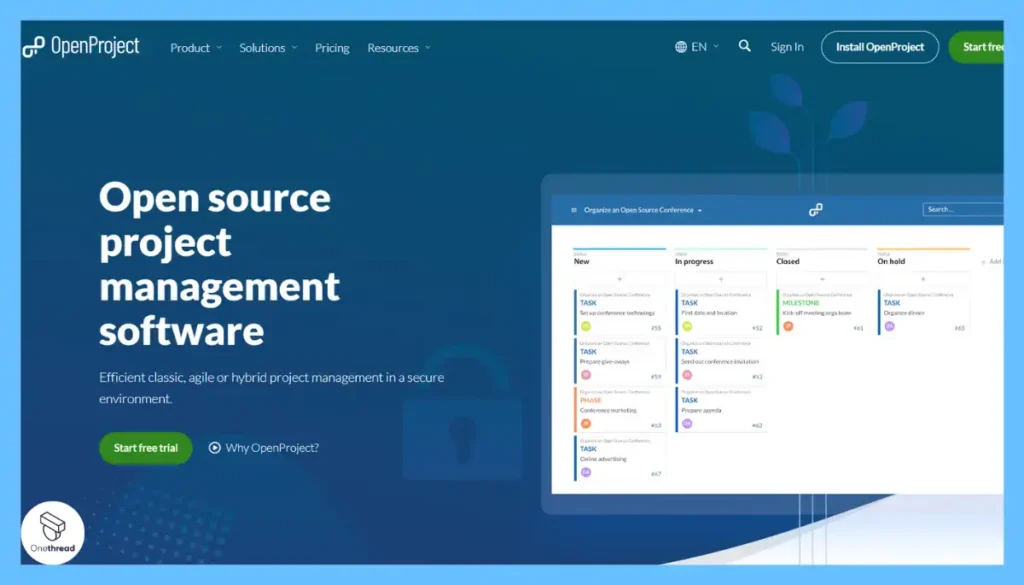
OpenProject stands out as the most versatile and full-featured open-source option for project management. During our testing, OpenProject impressed us with its robust set of tools for planning, tracking, reporting, and collaborating on projects. Features like Gantt charts, timelines, roadmaps, dashboards, and wikis are crucial for productive project management and OpenProject excels in providing them.
What we like most about OpenProject is how it supports both agile and traditional project management methodologies. The custom workflows, permissions, integration options, and enterprise-grade security also enable it to adapt seamlessly to any business need. While most open-source alternatives focus narrowly on only software teams, OpenProject suits all project types with its flexibility.
However, OpenProject can seem overly complex for non-technical users compared to simpler tools like Onethread. Its open-source roots also mean the interface lacks some refinement found in proprietary alternatives.
When weighing OpenProject against options like Wekan, it does not provide the same hyperfocus on core basics like Kanban boards.
Yet for an open platform with extensive features that technical teams can tailor to any scenario, OpenProject delivers immense value over trying to integrate multiple niche solutions. Its positioning as an all-in-one project collaboration platform makes it the best open-source choice for most organizations.
Features of OpenProject
Here are some key features of OpenProject as a leading open-source project management software:
Project Management Styles
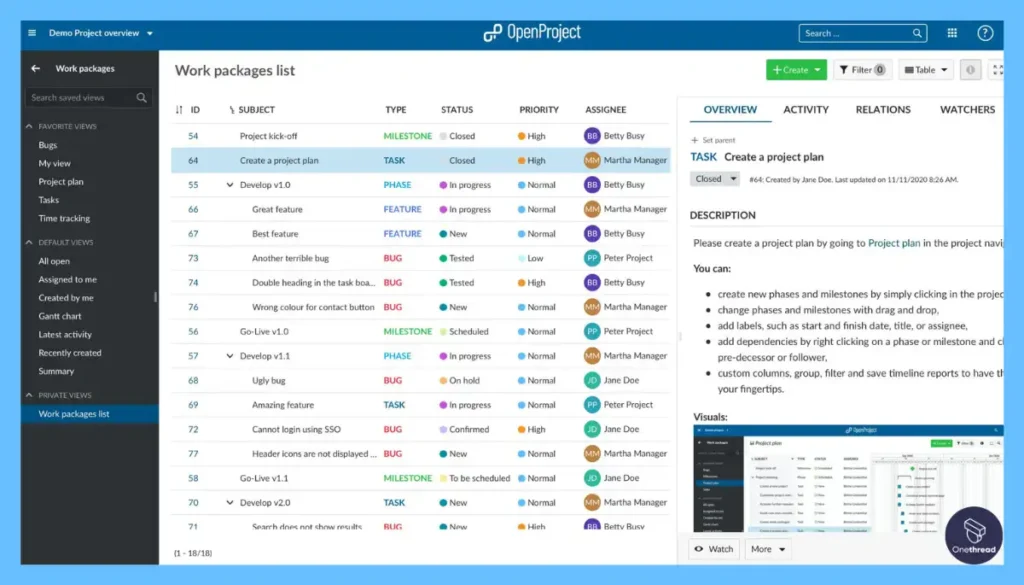
Whether you prefer classic, agile, or hybrid project management, OpenProject has you covered. It offers tools for task organization, team collaboration, and result tracking. This flexibility allows freelancers to adapt the software to various project needs.
Custom Workflows
OpenProject allows teams to design and automate customized processes, forms, fields, and permissions to match existing operational flows – crucial for adaptable tool alignment.
Portfolio Hierarchy
Projects can be structured in layered groups with dashboards rolled up for executives to view strategic organizational initiatives at a glance – solving visibility issues.
Project Planning and Scheduling
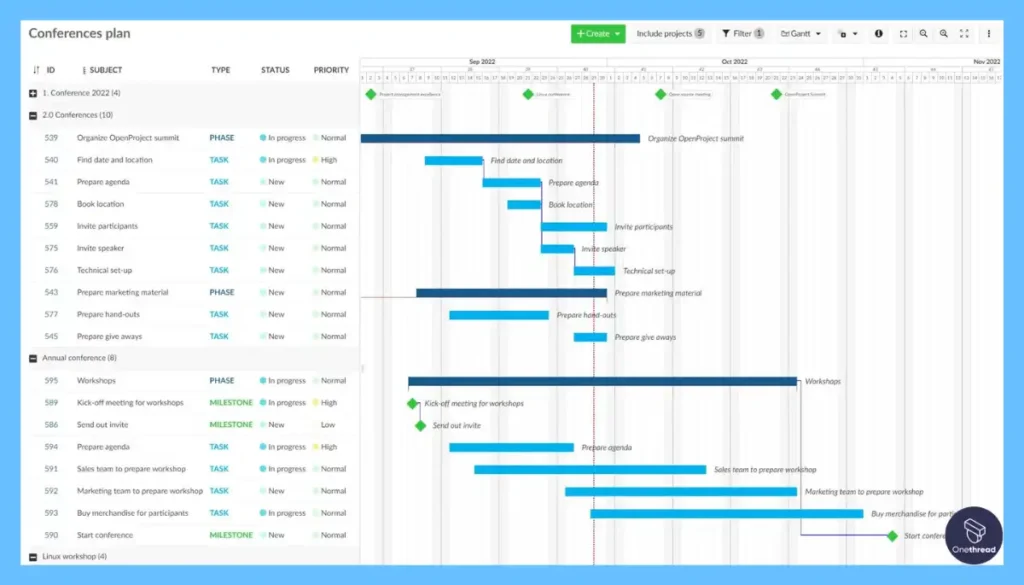
OpenProject comes with shared timelines for project planning. It helps you visualize your project scope and deliverables. This feature is particularly useful for freelancers who juggle multiple projects and deadlines.
Agile, Scrum & Kanban Support
For those who follow agile methodologies, OpenProject is a boon. It supports Scrum and Kanban, enabling better and faster iterations. Freelancers can benefit from this by streamlining their workflows and improving client deliverables.
Team Planner
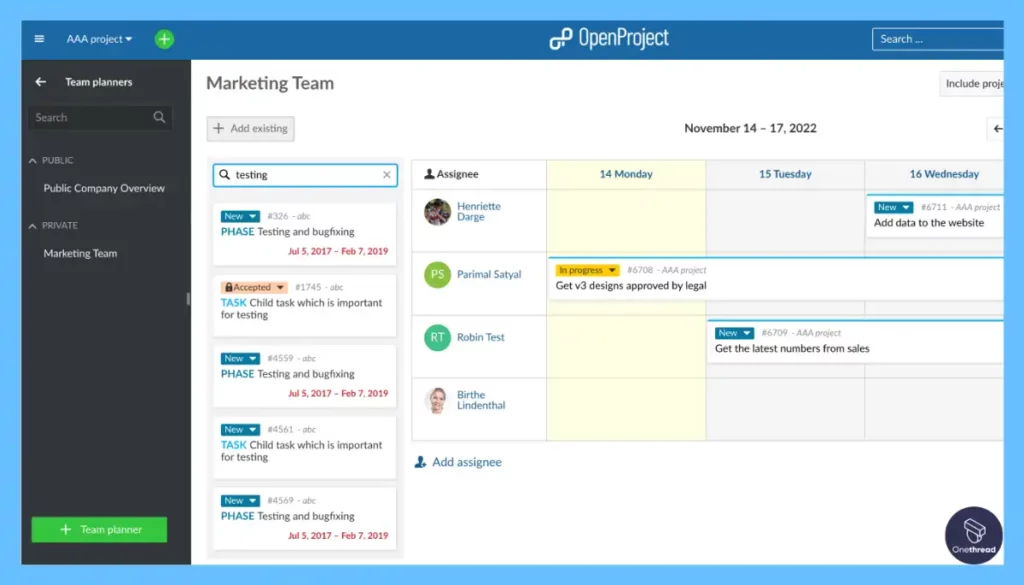
The Team Planner feature allows you to assign tasks visually. It offers a weekly or bi-weekly calendar to plan activities. This helps freelancers manage their time and resources effectively.
REST APIs
Developers can integrate other platforms used commonly in project management via OpenProject’s web APIs to prevent data silos – key for customized connectivity.
Pros of OpenProject:
- Supports various collaboration features like task management, agile boards, time tracking, etc.
- Offers tools for project planning, scheduling, budgeting, and cost reporting.
- Customizable workflows, forms, fields, and access permissions.
- API integration and enterprise-level support available.
- Secure authentication and data encryption.
Cons OpenProject:
- Can have a steep learning curve for some users.
- Must pay for premium support and some additional features.
- Minimum 5 users for paid plans may not suit smaller teams.
Pricing Plans
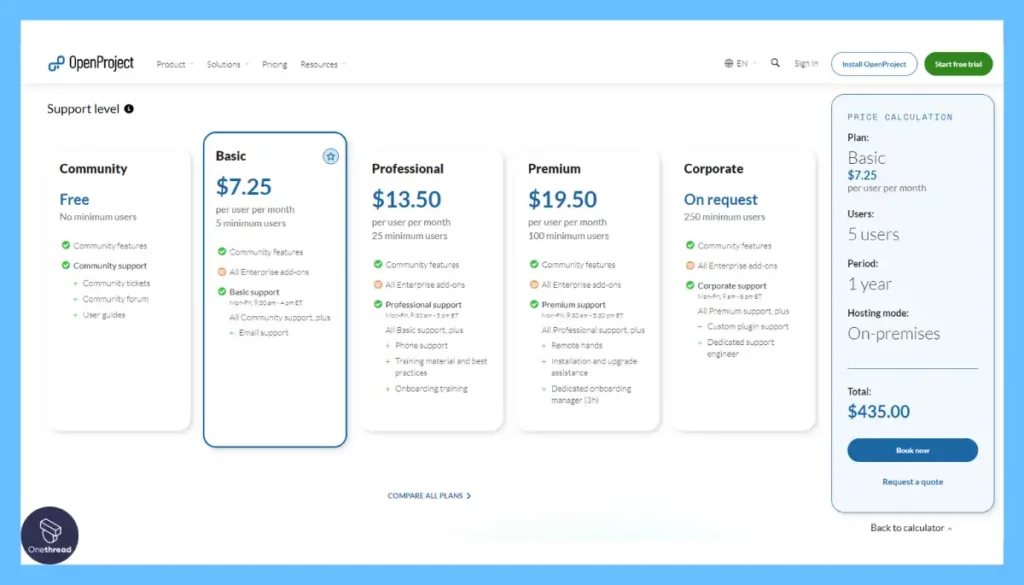
- Community: Free
- Basic: $7.25 per user/month
- Professional: $13.50 per user/month
- Premium: $19.50 per user/month
- Corporate: Custom pricing
There are options for cloud or on-premises hosting. Additional features and services, like BIM, vary in availability across plans. Discount rates are available for educational institutions and NGOs.
What Users Say About OpenProject?
Review on G2: 3.7 out of 5
“What do you like best about OpenProject?
It keeps track of every change, and a lot seems possible in terms of commenting and task descriptions.
What do you dislike about OpenProject?
The user experience isn’t very good. Navigating isn’t very easy or fast, and writing a task sometimes gives errors in both submitting as well as formatting.”- Verified User
3. ProjectLibre
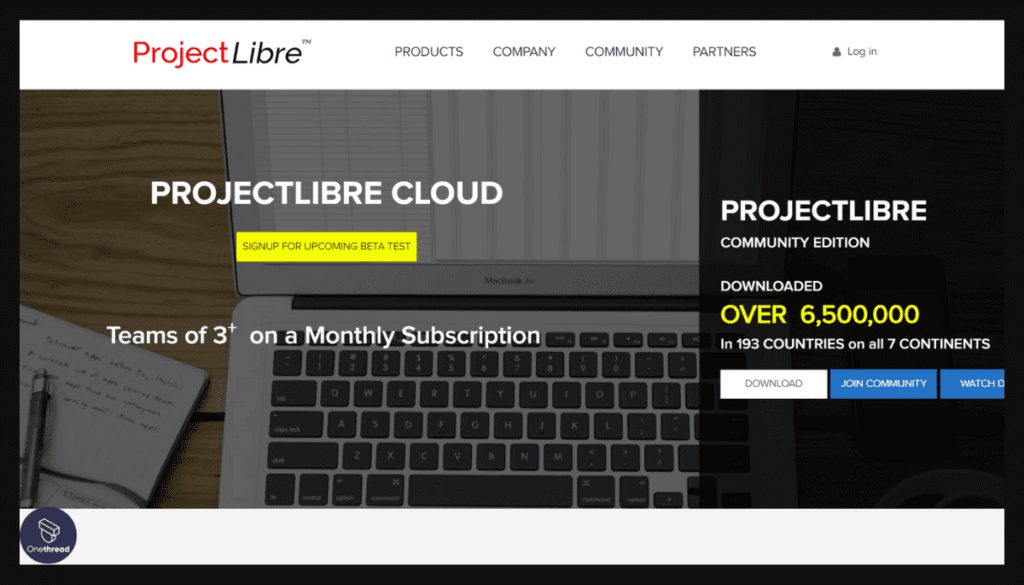
ProjectLibre emerges as another great open-source solution for robust project management capabilities. During testing, ProjectLibre impressed us with its seamless compatibility with opening Microsoft Project files – a crucial capability for businesses already relying on that software.
Beyond this, ProjectLibre offers versatile visual planning tools like Gantt charts and network diagrams that advanced project managers require.
What we like most about ProjectLibre is how it replicates premium features present in commercial tools without the typical cost barriers. Capabilities like earned value costing, detailed resource allocation, and different project chart views are all included for comprehensive project oversight. For global teams, ProjectLibre’s multilingual platform also expands its accessibility.
However, ProjectLibre lacks some of the newest forms of visualization found in tools like OpenProject. There is also less focus on agile frameworks that modern software teams utilize. The interface veers more traditional without some UI refinements visible in more modernized competitors.
Yet for project managers and planners who value robust compatibility and functionality over all else, ProjectLibre delivers immense value over it’s competitors. Its precise re-creation of advanced capabilities at zero cost makes it a leading open-source choice despite the dated aesthetics.
Features of ProjectLibre
Here are 6 key features of ProjectLibre as an open-source project management software:
Microsoft Project Compatibility
ProjectLibre seamlessly imports and exports Microsoft Project files, avoiding data lock-in for businesses reliant on that industry standard.
Multi-Project Dashboards
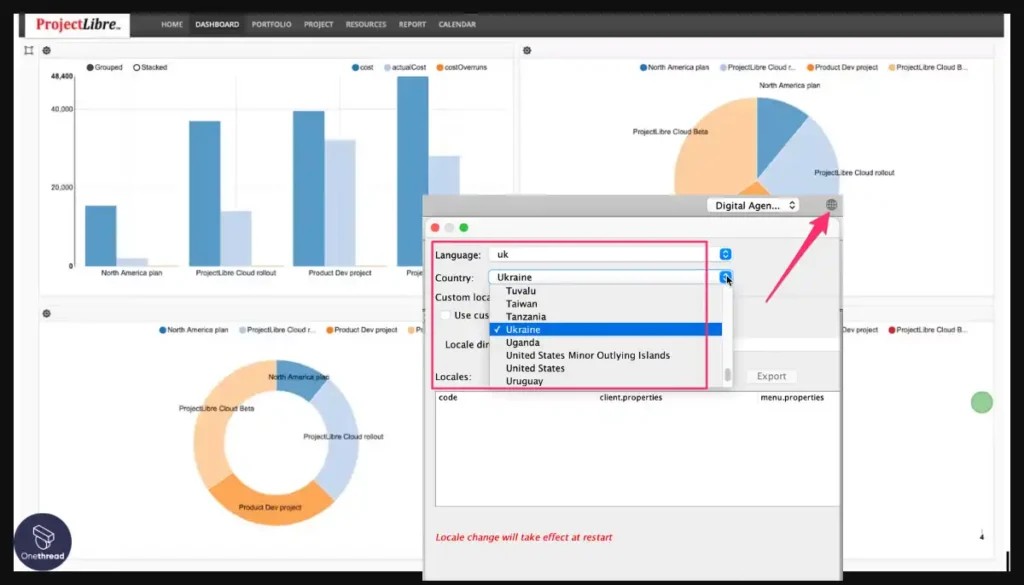
Unlike tools focused on individual projects, ProjectLibre consolidates reporting across initiatives for executives overseeing portfolios and programs.
Customizable Templates
Users can design reusable project, task, and resource templates tailored to different teams and methodologies to jumpstart new initiatives.
Automatic Progress Updates
ProjectLibre recalculates project forecasts and timelines in real-time as workloads shift, saving manual effort to sustain accuracy.
Multilingual Platform
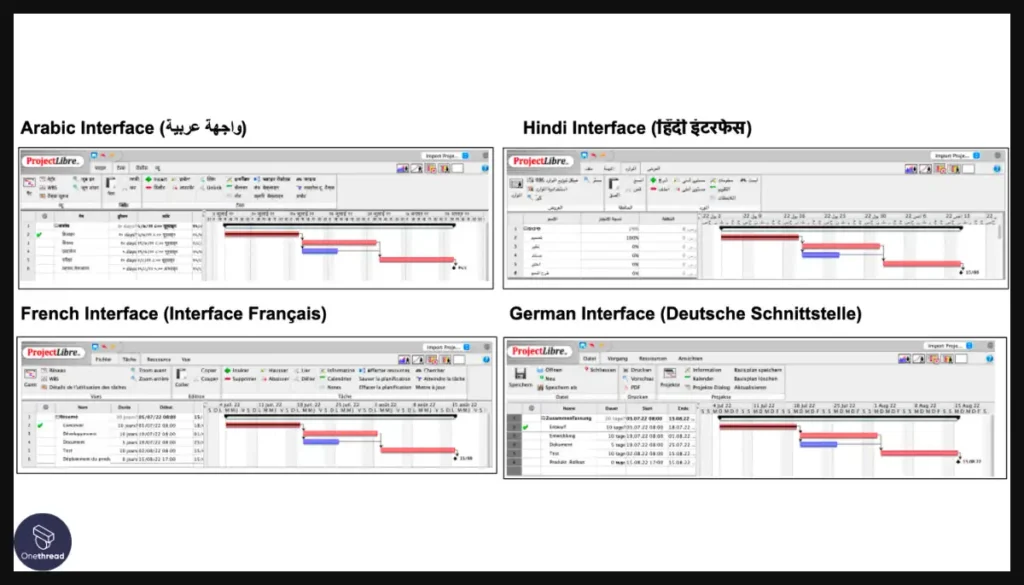
Already translated into languages like French, German, and Spanish, ProjectLibre enables global collaboration without exclusivity barriers common in English-first tools.
Offline Accessibility
Web and mobile apps allow managers to monitor projects, update progress, and adjust assignments even without live internet connectivity.
Pros of ProjectLibre:
- Works with Microsoft Project files for easy migration.
- Includes Gantt charts, WBS charts, earned value costing, etc.
- Available in multiple languages, good global reach.
- Robust features without the high cost of proprietary tools.
Cons of ProjectLibre:
- Limited integrations compared to other tools.
- Less versatile for non-software teams.
- Less active user community than some competitors.
Pricing Plans
- 100% free and open source
What Users Say About ProjectLibre?
Review on G2: 4.2 out of 5
“What do you like best about ProjectLibre?
It is used to manage the infrastructure and progress of the project. We can assign project elements to the team members. The work can be viewed in a spreadsheet. The Gantt chart is handy for users.
What do you dislike about ProjectLibre?
It isn’t effortless to use for new users. The implementation of the rates of per-person work might sometimes be complex. Freezing of screen is quite often in this application.”- Ashlesh S.
4. Taiga
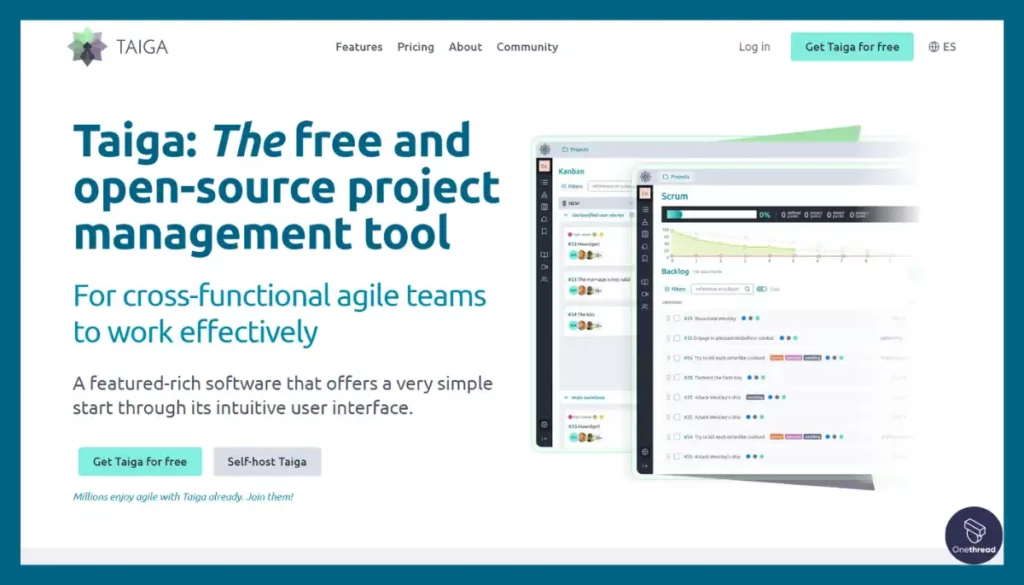
Taiga offers one of the most user-friendly open source solutions tailored specifically for agile teams fully embracing Scrum and Kanban. Taiga stands out with its flexibility enabling deep customization of boards, workflows, reports, and other elements to suit any team’s structures and preferences.
We also like Taiga’s strengths in issue tracking and community translations to facilitate collaboration across global organizations.
What we appreciate the most in Taiga is the product’s positioning for simplicity, avoiding the steep learning curves common in open-source tools. With an interface any agile practitioner can intuitively adopt, Taiga delivers value on its core purpose of facilitating iterative delivery without barriers. Taiga also provides free cloud hosting options that remove infrastructure burdens facing most open-source platforms.
Compared to a more expansive option like OpenProject, Taiga lacks portfolio management capabilities or the ability to oversee traditional projects. It also cannot match the premium support services or breadth of integrations seen in paid platforms.
However, for agile teams wanting an accessible open-source solution to start small before expanding operational maturity, Taiga delivers immense value. Its specialization provides a lighter-weight complement filling a specific gap compared to heavier toolsets like Wekan.
Features of Taiga
Here are the key features of Taiga as an open-source agile project management software:
Custom Kanban Cards
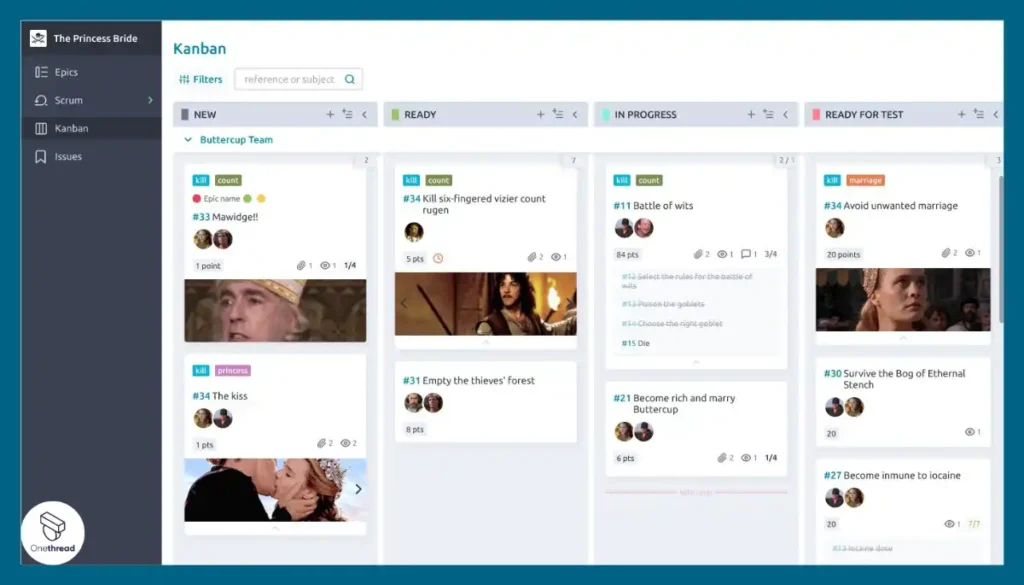
Kanban boards support detailed epics, sub-tasks, attachments, activities, and custom fields for user-defined requirements without restricting workflows.
Configurable Notifications
Instead of blanket alerts, individual users can tailor notifications around assigned tasks, watched epics, activity streams, and code commits.
Project Templates
Structures for epics, user stories, sprints, and previous projects can kickstart initiatives without repetitive setup work.
Agile Support
Taiga is designed to improve your agile team’s performance. Whether you’re using Scrum or Kanban, Taiga has the tools to make your workflow smoother. This is particularly beneficial for freelancers who work in agile environments and need to adapt quickly to client needs.
Burndown Charts
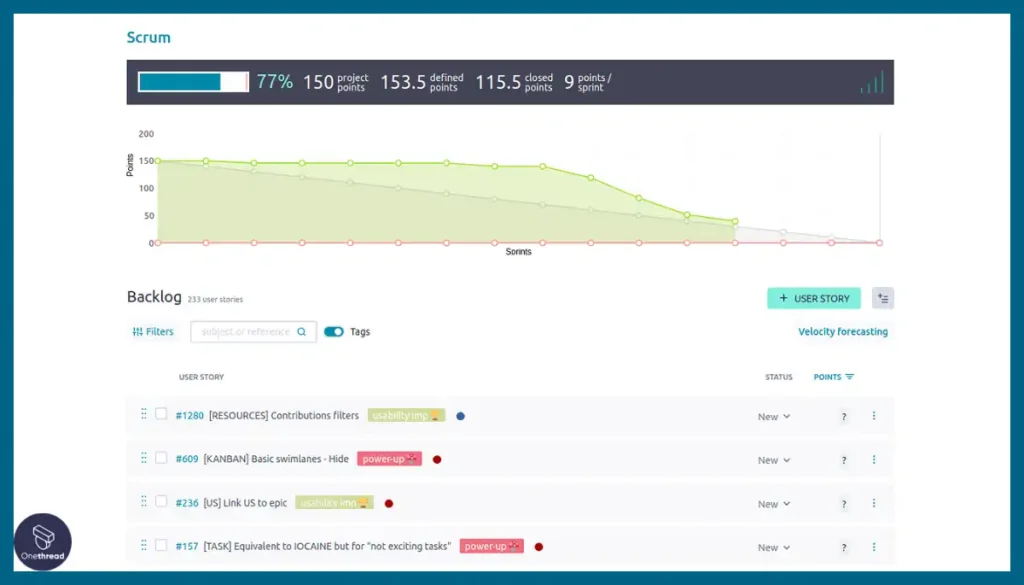
Taiga focuses visuals on tracking sprint progress towards completion goals rather than top-down Gantt charts to align with agile values.
Wiki Integrations
Teams can interlink project activity with centralized documentation for contextual access without hopping between siloed tools.
Community and Support
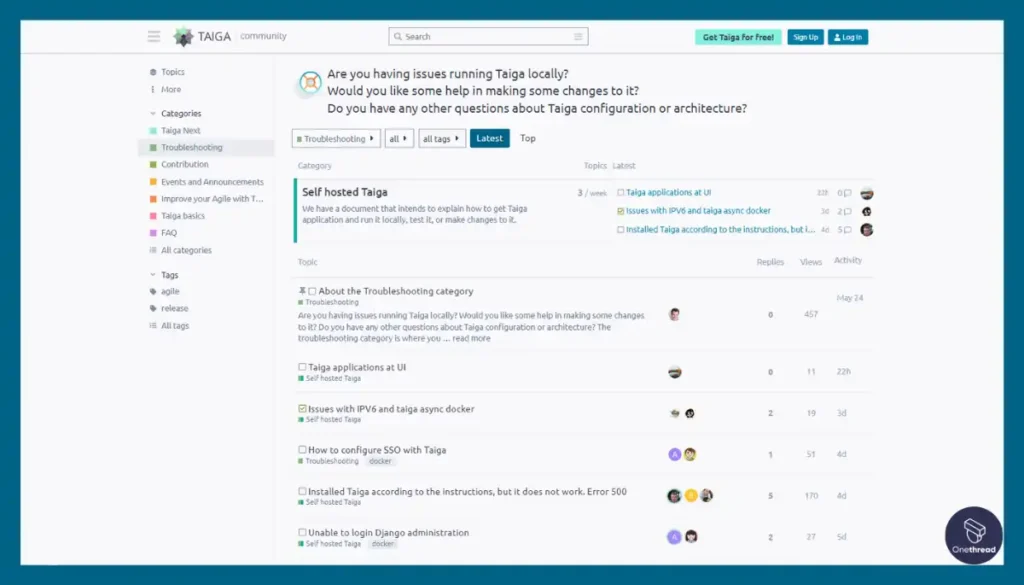
Taiga’s community offers extensive troubleshooting help, a strong community for discussions and contributions, regular updates on news and events, and a comprehensive FAQ section. This support is especially beneficial for freelancers seeking knowledge, resources, and platform updates.
Multilingual Translation
Already localized into languages like French, German, Portuguese, and Chinese, Taiga bridges global collaboration barriers around English-centric software.
Pros of Taiga:
- Intuitive user interface, easy to onboard.
- Supports Scrum and Kanban, useful for agile teams.
- Integrated issues tracking and reporting.
- Highly customizable, role definitions and tags.
- Translation in 20+ languages.
Cons of Taiga:
- Less focus on financial features like budgeting.
- Integration ecosystem not as developed as larger tools.
- Mostly suited for software/tech teams.
Pricing Plans
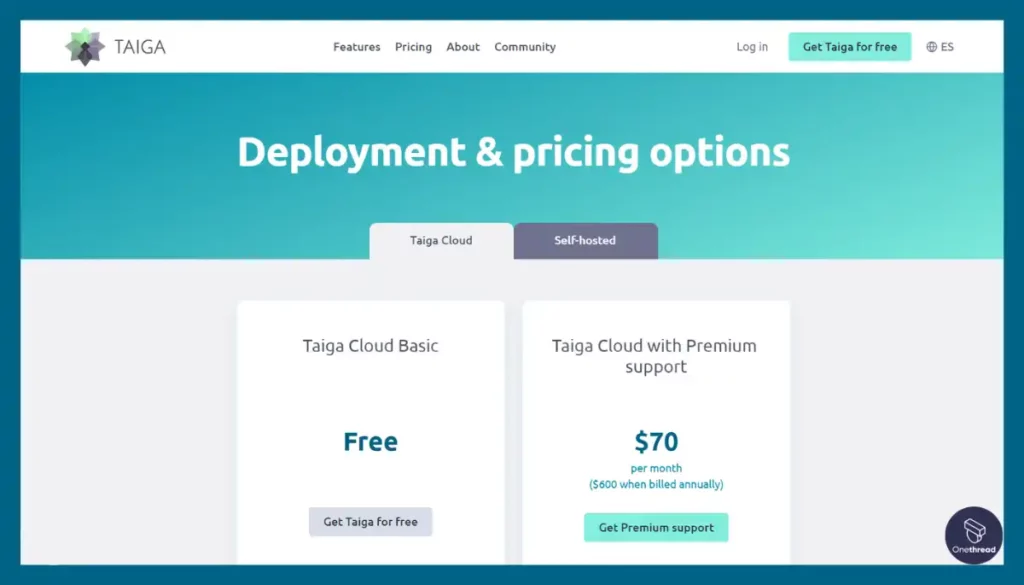
Taiga offers two cloud-based pricing options:
- Taiga Cloud Basic: Free
- Taiga Cloud with Premium Support: $70 per month
Taiga’s self-hosted pricing options include:
- Self-Managed: (Free): Requires Linux and Docker experience.
- Automated-Hosting: Starts at $10
- Managed For You: Custom Pricing
What Users Say About Taiga?
Review on G2: 4.4 out of 5
“What do you like best about Taiga?
Taiga is the most useful interference in that we use platforms. It is very easy to use and very user-friendly. Also, It has a qualified help center and provides good quality.
What do you dislike about Taiga?
Taiga has limited language experience. Our partners can feel hesitant to use it. On the other way, they can compensate for this issue with sections inside the site.”- Günce D.
5. GanttProject
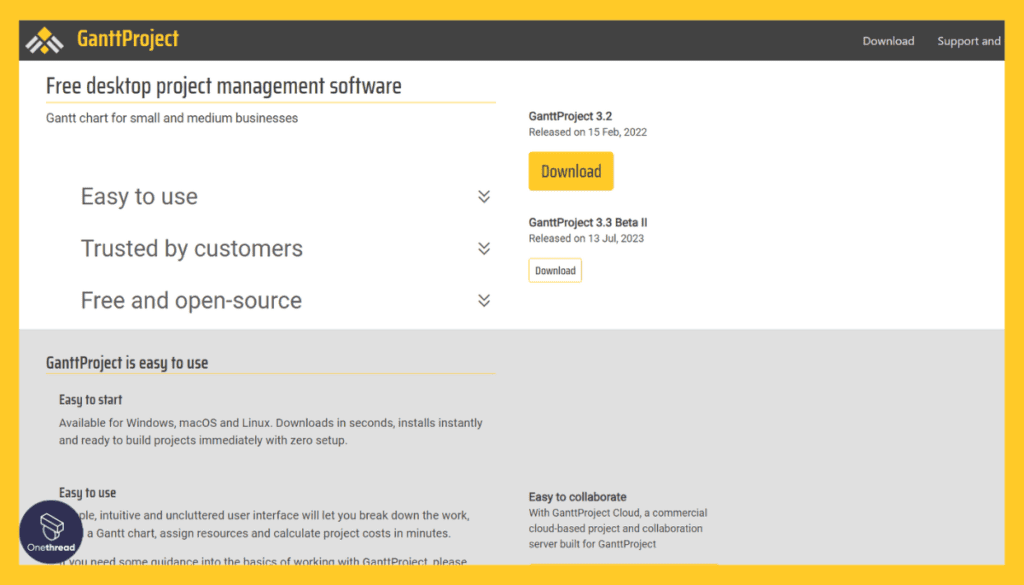
GanttProject offers one of the most robust open source solutions focused specifically on advanced Gantt chart capabilities for planning and scheduling projects.
During our testing, GanttProject showcased its versatility in supporting traditional waterfall development even as competitors drift towards agile-first designs. We also like GanttProject’s stability as an established platform in continuous development for nearly 20 years.
What stands out most about GanttProject is the intricate Gantt functionality comparable to Microsoft Project – a crucial capability for project managers working with that industry standard. By replicating features like baselines, task dependencies, and critical path oversight in a free tool, GanttProject unlocks significant value. Recent additions like the GanttProject Cloud also expand its collaboration strengths.
However, for project teams utilizing agile frameworks, GanttProject lacks rich support for Scrum or Kanban methodologies compared to tools like OpenProject or Taiga. Its focus exclusively on the Gantt chart also renders it one-dimensional for organizations seeking an all-in-one management solution.
Yet for planning complex projects that need reliable Gantt chart software without the cost, GanttProject delivers immense value catering very effectively to that niche requirement where other open source options fall short.
Features of GanttProject
Here are 6 key features of GanttProject, an open-source solution for Gantt chart-based project management:
Native Microsoft Project Support
GanttProject can import and export MPP files while matching complex features like baselines, lag/lead constraints, and critical path visibility crucial for migrating from that industry standard.
Web-Based Collaborative Planning
Complementing the desktop app, GanttProject Cloud enables real-time remote project planning and task coordination for distributed teams through shared Gantt chart access with change alerts.
Customizable Appearance
Users can tune visual preferences like chart colors, font sizes, diagram styling, and calendar formats to tackle accessibility needs without impacting indispensable functionality.
PDF/PNG Exports
Gantt charts along with task tables can be exported as-is into fixed, universally compatible formats for sharing progress visuals during stakeholder presentations or gathering sign-offs.
Task Mode Switching
For planning flexibility, task arrangement can toggle between 3 modes: Overview displaying all project tasks linked chronologically, Resources listing tasks under assigned owners, and Resources Overview blending both views.
Built-In Resource Histograms
Alongside Gantt charts, horizontal bar histograms provide supplementary visibility into resource allocation peaks helping managers identify and prevent overbooking issues.
Pros of GanttProject:
- Available across Windows, Mac, and Linux.
- Imports/exports Microsoft Project files.
- Includes cost calculation features.
- Option for secure cloud collaboration.
- Long-standing history (since 2003).
Cons of GanttProject:
- Limited features compared to fuller PM solutions.
- Less intuitive interface than newer tools.
- Requires desktop app and cloud account for full functionality.
Pricing Plans
- Open Source Desktop App: Free
- GanttProject Cloud: Starts at €1 per active user/month
What Users Say About GanttProject?
Review on G2: 4.3 out of 5
“What do you like best about GanttProject?
User-friendly interface makes the software useful also for beginners
What do you dislike about GanttProject?
All the graphics shall be updated with something more catchy”- Carmine M.
6. Kanboard
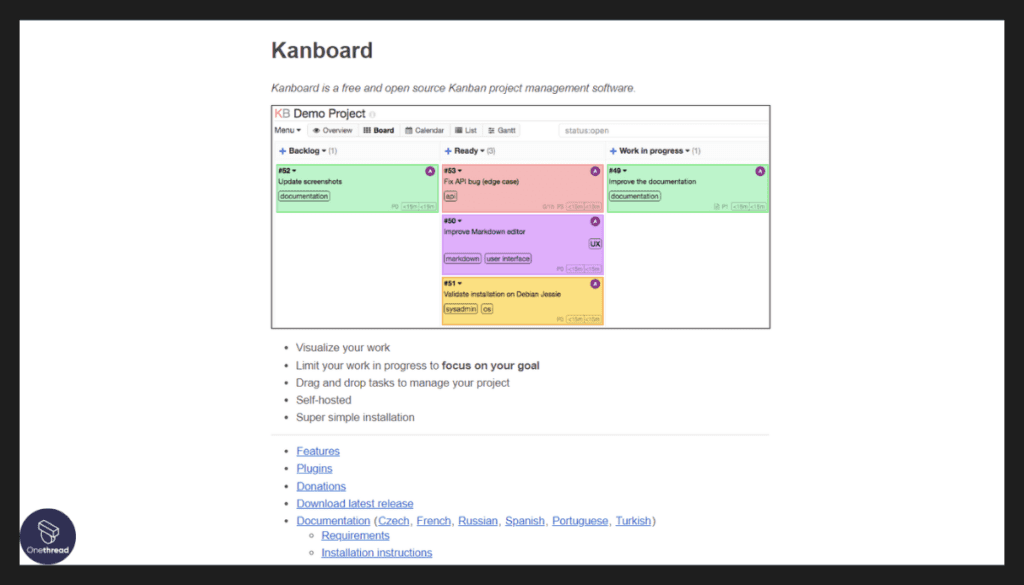
Kanboard stands out as one of the most lightweight and easy-to-use open-source Kanban solutions available. Its meticulous focus on providing an intuitive Kanban interface without the complexities bogging down other platforms makes it one of a kind.
We also like Kanboard’s configurability through advanced filtering, task breakdowns, and automatic triggers – allowing customization without complication.
What our reviewers appreciate most about Kanboard is its emphasis on usability to facilitate adoption across organizations averse to burdensome new software. With versatile authentication options to fit any technology infrastructure and multilingual translations, Kanboard removes obstacles for diverse teams getting started. The minimalism also reduces distractions to keep staff productive with work-in-progress limits and clear workflows.
Compared to more expansive tools like OpenProject or Wekan, Kanboard admittedly lacks portfolio management features, reporting, or capabilities beyond Kanban boards.
However, for teams wanting a straightforward, open-source Kanban solution to implement without headaches, Kanboard delivers immense value. Its positioning caters perfectly to that niche where other platforms either overwhelm with scope creep or fail to provide the configurability that growing teams eventually need.
Features of Kanboard
Here are the key features of Kanboard, an open-source Kanban project management software:
Customizable Task Cards
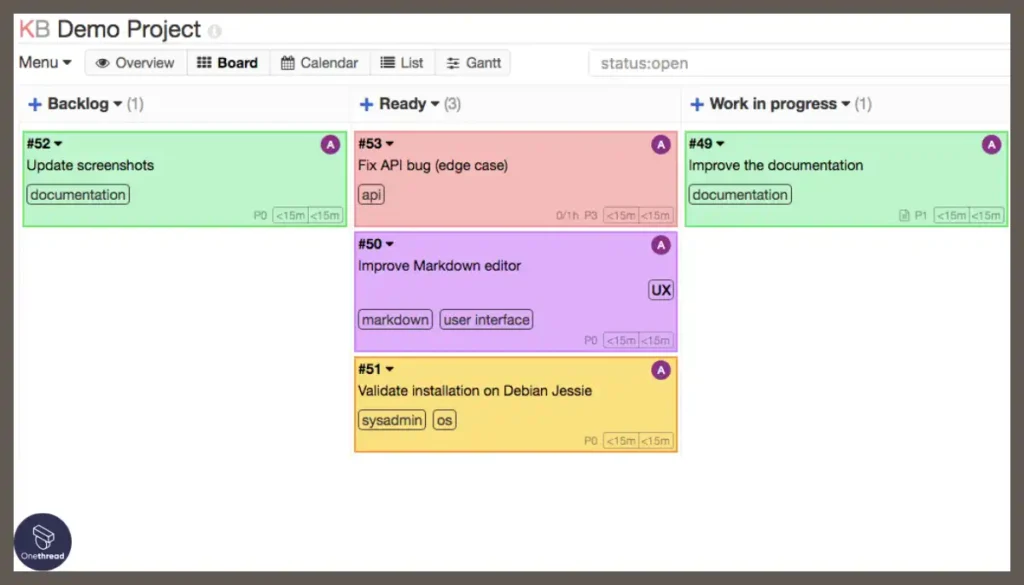
Kanban cards support formatting options like task breakdowns, comments, activities, attachments, tags, colors, and due dates for configurable workflows without restrictions.
Focused Visuals
Kanboard amplifies visibility by hiding archived tasks and keeping views centered on immediately actionable work-in-progress – crucial for productivity.
Instant Search
Keyboard shortcuts can pull up a task search overlay to instantly reveal cards site-wide by descriptor words, unlike nagivating complex filtered views saving managers time.
Automatic Triggers
When preset conditions are met like overdue tasks or blocking roadblocks, automatic alerts notify assignees through emails while updating the Kanban board keeping all stakeholders aware.
Data Ownership
Kanboard offers on-premise, single-server deployment allowing organizations to retain full data control instead of relying on proprietary cloud platforms outside audit bounds.
Access Flexibility
Alongside conventional logins, Kanboard facilitates authentication through secure protocols like LDAP or OAuth to accommodate specialized external tools securing identity and access.
Pros of Kanboard:
- Simple and lightweight interface.
- Clear Kanban board for visual task workflow.
- Easy drag-and-drop functionality.
- Advanced task filtering capabilities.
- 30+ language translations available.
Cons of Kanboard:
- Very basic compared to more complex PM tools.
- Lacks portfolio management, reporting, etc.
- Not suitable for large, intricate projects.
- Limited integrations with other platforms.
Pricing Plans
- 100% free and open source
What Users Say About Kanboard?
Review on G2: 2.5 out of 5
“What do you like best about Kanboard?
I like how easy it is to add projects and timelines and assign them to the designated teams.
What do you dislike about Kanboard?
The aesthetics of the software need a good refresh. It’s a bit “Reddit” like in appearance.”- Verified User
7. Orangescrum
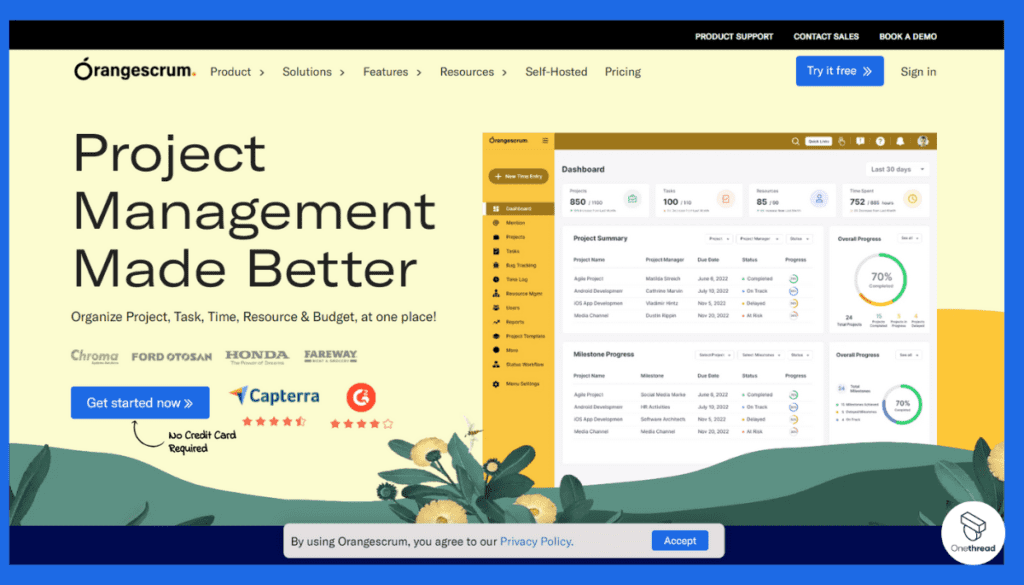
Orangescrum offers one of the most security-focused open-source platforms for comprehensive project oversight. Orangescrum impressed us with advanced features like budgeting and financial tracking alongside traditional task management – capabilities that few competitors provide. We also like Orangescrum’s on-premise hosting option enabling organizations to retain complete data control.
What stands out most about Orangescrum is its ability to scale from basic planning needs up to enterprise-level portfolio management without the steep learning curves of niche tools. With versatile features from timesheets to customizable workflows, Orangescrum adapts to teams throughout their maturation. Role-based access and permissions also ensure collaborators only interact with relevant information as projects grow more complex.
Compared to other open-source tools, Orangescrum does lack some of the latest third-party integrations and snazzy interfaces as a relatively younger platform.
Yet for organizations seeking open-source stability, configurability, and security as projects progress from simple to sophisticated, Orangescrum delivers immense value where competitors fall short on custom controls or advanced functionality present in proprietary software.
Features of Orangescrum
Here are some key features of Orangescrum as an open-source project management software:
Task Management
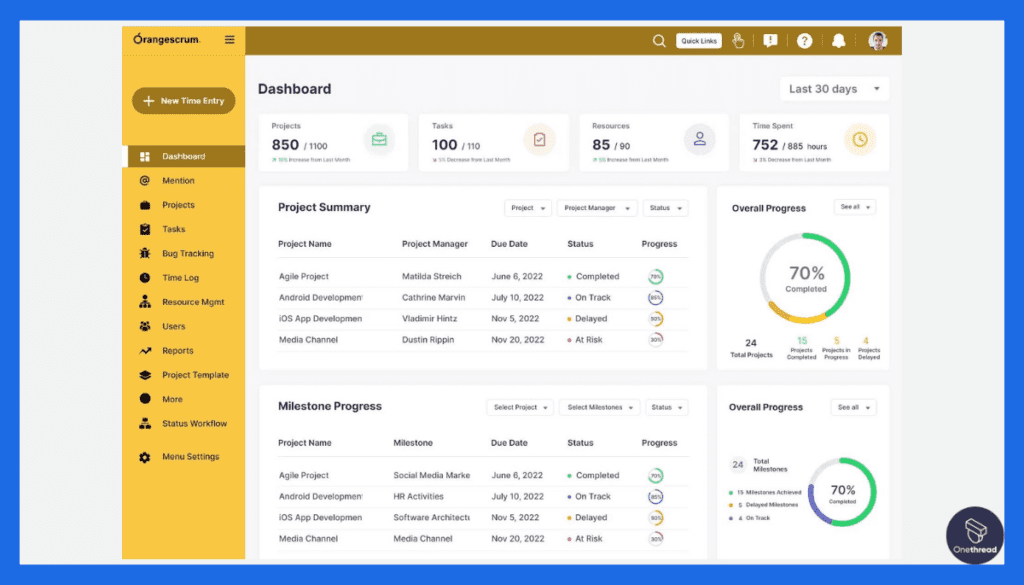
Add, edit, and categorize tasks with due dates, assignees, priorities, etc. to break down work into manageable units. Customizable workflows to map business processes. Helps organize work, and ensures accountability.
Kanban Boards
Visualize tasks on highly flexible Kanban boards that can be customized with unlimited columns, WIP limits, colors, etc. to match workflow. Smooth drag-and-drop movement of tasks between sections for better prioritization.
Time Tracking
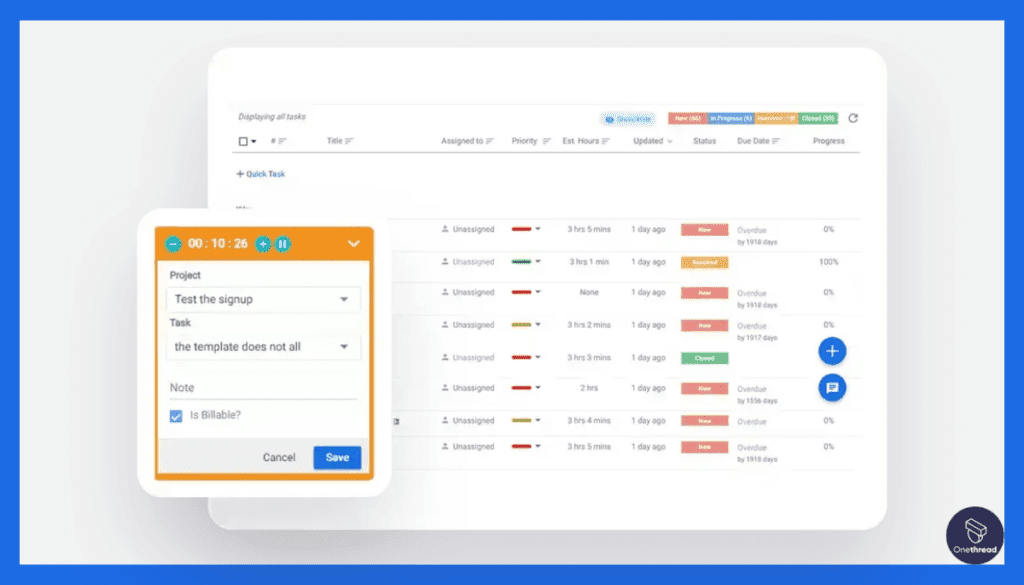
In-built timer allows accurate time tracking at task level. Log time directly or manually add it later. Useful reports on time spent by project, user, etc. help estimate budgets and bills.
Multiple Project Views
Work on unlimited projects and seamlessly switch between list, board, calendar, and Gantt views for each. Helps flexible planning, and tracking of multiple projects. Also possible to relate tasks across projects.
Access Control
Granular access control at the project level for members. Set individual permissions, and allow only relevant teammates to view/edit specific projects or tasks as per roles.
Team Availability and Skills
Knowing your team’s availability, skills, and utilization is crucial for effective project management. Orangescrum provides these insights, making it easier for freelancers to allocate resources efficiently.
Customizable Workflows
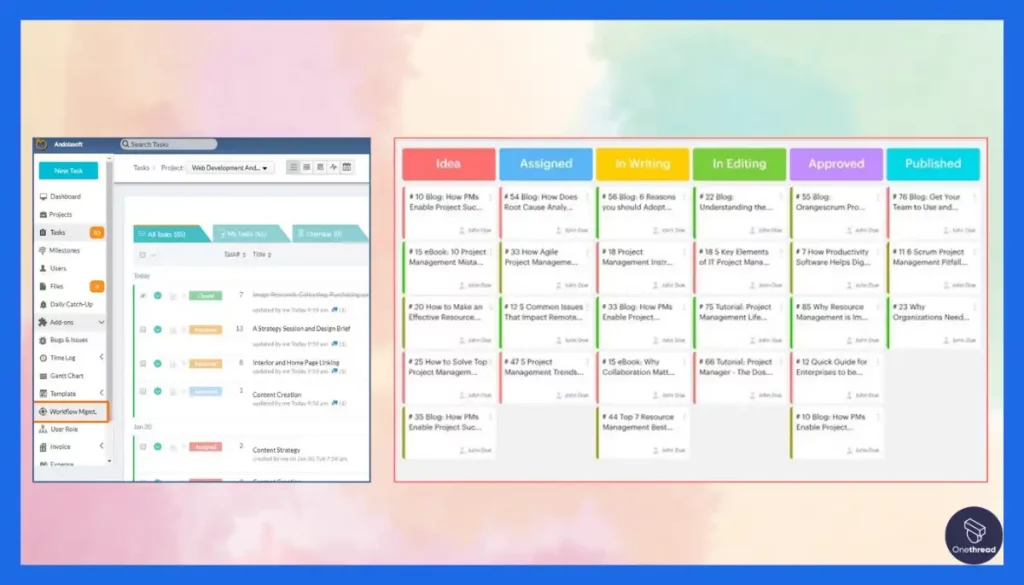
Orangescrum allows you to create your own project workflows. This feature is invaluable for freelancers who have specific project management styles and need a tool that can adapt to their needs
Client Collaboration
The software enables project collaboration with clients. Freelancers can share project updates and receive feedback directly within the platform, streamlining communication and ensuring everyone is on the same page.
Community Support
Active community forums for queries, access to documentation, and guides. Additional support from the developer community for help in setup, integrations, and troubleshooting issues.
Pros of Orangescrum:
- Data privacy with on-premise hosting option.
- Budgeting, resource management, timesheets.
- Customizable workflows, fields, and permissions.
- Useful reporting dashboards and analytics.
- Integrates with other tools.
Cons of Orangescrum:
- Can seem complex for smaller teams.
- Must pay per user for core features.
- Limited free version functionality.
Pricing Plans
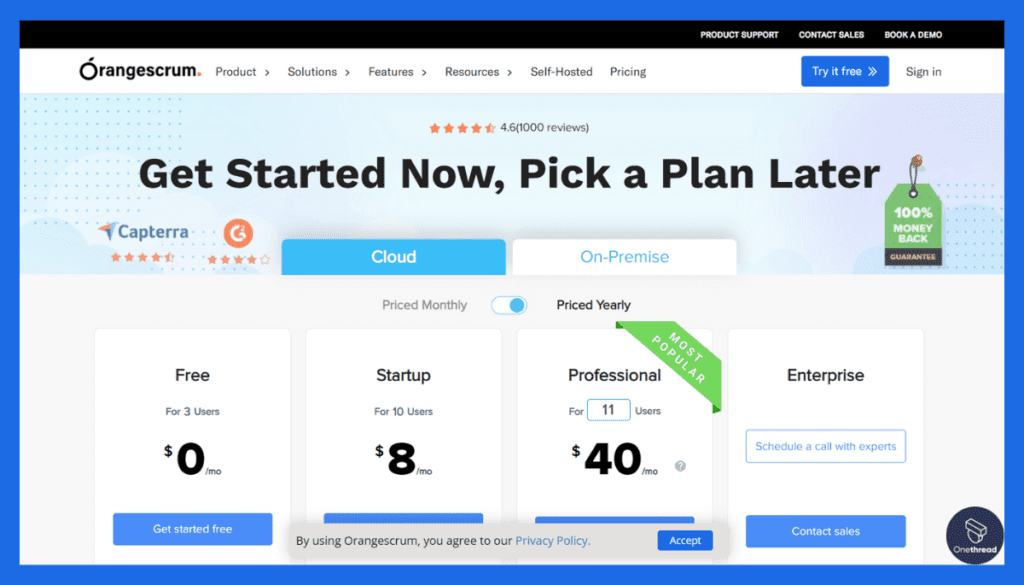
- Personal: Free
- Startup: $8 per month
- Professional: $3.6 per user/month
- On-Premise: Custom pricing (Starts at $1,099 for 10 users for one year)
What Users Say About Orangescrum?
Review on G2: 4.5 out of 5
“What do you like best about Orangescrumt?
I’m using the community edition to create tasks and assigning them fascinates me the most.
What do you dislike about Orangescrum?
The community edition is way too basic. It should contain at least drag and drop for task status.”- Rehan L.
8. Wekan
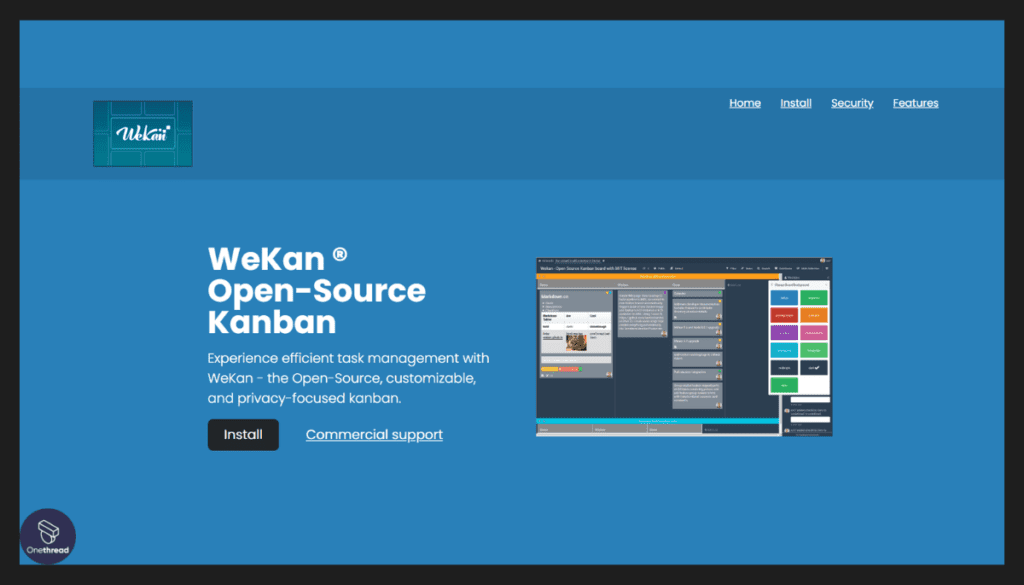
Wekan emerges as one of the simplest yet most flexible open-source Kanban boards available. As we thoroughly evaluated Wekan’s capabilities, the platform showcased excellent real-time task coordination features combined with a very gentle learning curve.
Wekan also enables smooth self-hosting for data ownership – a major advantage over cloud-based competitors.
Our team appreciated Wekan’s effectiveness in providing only essential task visualization features without unnecessary complexity. With intuitive drag-and-drop mechanics and lean workflow configuration options, teams can start collaborating almost instantly. Wekan also empowers users with multi-language support and cross-platform accessibility.
Compared to tools like Taiga, Wekan trails slightly regarding reporting outputs or integration with supplementary systems. The bare-bones approach also lacks portfolio views or financial tracking offered in tools like OpenProject.
However, for groups seeking a hassle-free open-source Kanban solution, Wekan delivers immense value. Its simplicity stands out from opponents focused on feature-heavy toolsets that take months to master and utilize completely. Wekan’s purity of purpose makes it shine for focused agile teams.
Features of Wekan
Here are 6 key features of Wekan as an open-source project management software:
Task Management
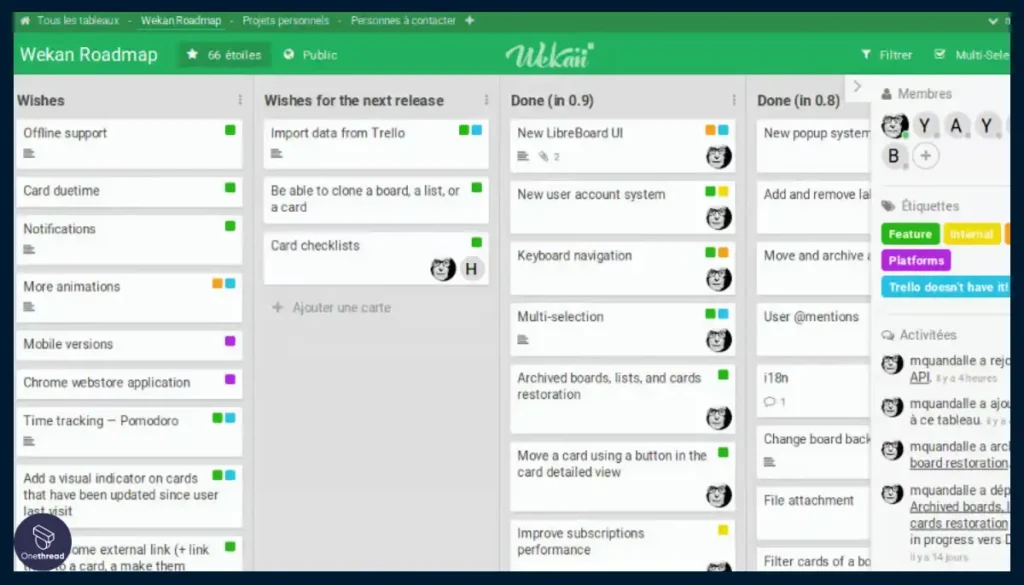
Comprehensive task management features like categories, assignments, comments, attachments, etc. Kanban boards to visualize tasks. Helps track work.
Flexible Workflows
Set up customizable workflows with statutes, columns, swimlanes, roles, etc. to map business processes. Intuitive drag-and-drop movement of tasks between workflow stages.
Interactive Gantt Charts
Visually plan projects on interactive Gantt charts. Set dependencies between tasks, and track progress with color-coded task bars. Easily adjust the schedule by dragging bars.
Granular Access Control
Manage access at project, category, and task levels. Set individual permissions – who can view/edit what. Useful for large teams with complex access needs.
Time Tracking
Log time spent on tasks with the built-in timer. Generates reports on time logged by project, user, task, etc. for billing purposes.
Community Support
Documentation, guides, and active community forums for support. Additional help from the developer community for troubleshooting setup, integrations, etc.
Pros of Wekan:
- Simple, intuitive Kanban interface.
- Easy to customize boards, lists, and cards.
- Drag-and-drop task management.
- Strong focus on security and privacy.
- Lightweight and self-hosted option available.
Cons of Wekan:
- Very basic, lacks portfolio management.
- Not suitable for intricate projects.
- Limited reporting and analytics features.
- Integrations not as robust as larger platforms.
Pricing Plans
- 100% free and open source
What Users Say About Wekan?
Review on G2: 4.2 out of 5
“What do you like best about Wekan?
Really easy to use and understand, yet powerful.
It focuses on the basics and does it well. The user interface is nice and easy to handle even for a non-tech person. It’s a small project management tool for… small projects.
It’s free (as in free beer) and open source. You can host it on a modest server, it’s easy to install.
What do you dislike about Wekan?
With few to no customisation possible big projects can be a mess to manage. There are no per-user authorizations.
You will need one board per project.”- Gaël A.
Key Features to Consider in Open Source Project Management Software
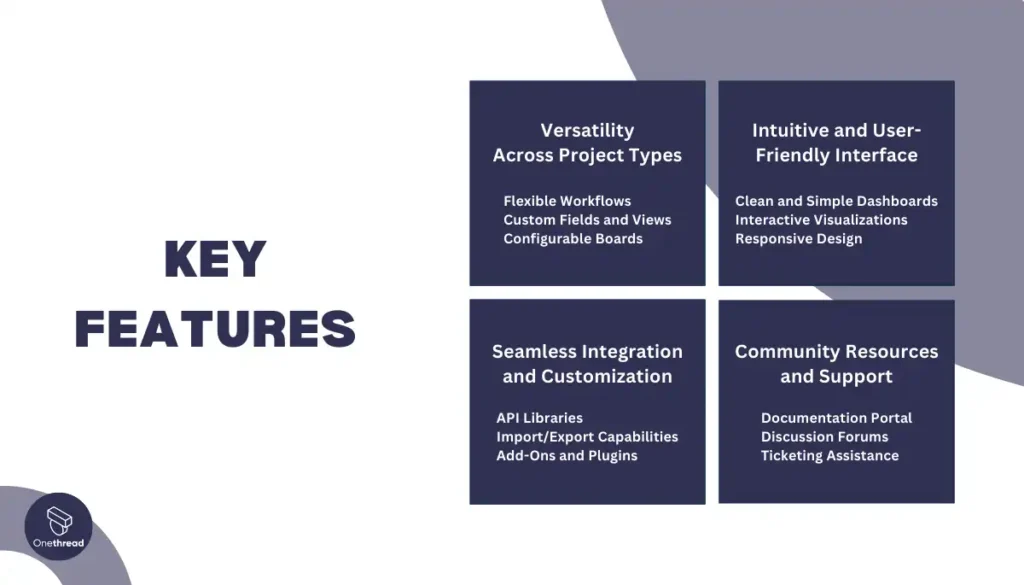
Selecting the right open source project management software can significantly impact your team’s efficiency and project success. To make an informed choice, it’s crucial to understand the key features that distinguish these tools.
Let’s explore the essential features to consider when evaluating open-source project management software.
Versatility Across Project Types:
Look for a platform that facilitates:
- Flexible Workflows: Support for both Agile and Waterfall methodologies.
- Custom Fields and Views: Ability to track data and visualize workflows for any project type.
- Configurable Boards: Kanban, Scrum, or list views to match various team structures.
Intuitive and User-Friendly Interface:
See if the software provides:
- Clean and Simple Dashboards: Easy to navigate without training, accessible across roles.
- Interactive Visualizations: Charts, graphs, and calendars tailored to project views.
- Responsive Design: Cross-device accessibility without compromising on features.
Seamless Integration and Customization:
Evaluate how easily it connects with other systems:
- API Libraries: Ability to build custom integrations as needed.
- Import/Export Capabilities: Migrate data between other project tools.
- Add-Ons and Plugins: Extend functionality with third-party enhancements.
Community Resources and Support:
Leverage open-source knowledge sharing:
- Documentation Portal: Articles, guides, and resources to learn the platform.
- Discussion Forums: Peer communities to exchange best practices and troubleshooting.
- Ticketing Assistance: Direct access to developer/community support when needed.
The focus should be on elements that offer flexibility, ease of use, seamless connectivity, and available help channels crucial for open-source project collaboration.
Choosing the Best Open Source Project Management Software
Choosing the best open-source project management software (OSPMS) can seem daunting, especially with the array of options available and potential pitfalls to avoid. But fear not! This guide helps you navigate the landscape and select the perfect tool to empower your team.
Identifying Your Needs:
Project Type:
Are you building software, crafting furniture, or managing a research team? Choose an OSPMS that’s flexible enough to adapt to your project’s unique demands. Versatile tools like Onethread and OpenProject work across industries, while Taiga shines in agile software development.
Technical Expertise:
Is your team tech-savvy or new to project management tools? Prioritize user-friendliness if complexity is a concern. Onethread, GanttProject, and Kanboard offer simple interfaces, while OpenProject, though customizable, can have a steeper learning curve.
Collaboration and Scale:
Do you need cross-project features or work simultaneously on multiple projects? OpenProject and Orangescrum excel in multi-project management, while Kanboard thrives in smaller, focused teams.
Conquering Common Pain Points:
Setup and Configuration:
Opt for easy installation and deployment like Kanboard or Onethread. If self-hosting is crucial, consider OpenProject or ProjectLibre, but be prepared for some technical configuration.
Limited Free Features:
Many OSPMS offer robust free versions, like Onethread, Kanboard, and GanttProject, with full feature sets available in paid plans. Evaluate your needs carefully before upgrading.
Outdated Interfaces:
Bid farewell to dinosaur interfaces! Modern OSPMS like Onethread and Orangescrum prioritize intuitive design and user experience.
Prioritizing Key Features:
Task Management and Visualization:
Look for tools like Onethread and Kanboard with effective task boards, or OpenProject for diverse options like Gantt charts and Kanban.
Time Tracking and Agile Tools:
For teams using time tracking or specific agile methodologies, prioritize tools like OpenProject with comprehensive features and integrations.
Integrations and Compatibility:
Ensure seamless integration with existing tools like GitHub Enterprise or project management platforms. Orangescrum boasts extensive integrations, while OpenProject offers flexibility through customization.
Documentation and Support:
Robust documentation and active communities, like those found around OpenProject and GanttProject, can be invaluable resources.
Customization and Flexibility:
Don’t settle for one-size-fits-all! Look for tools like OpenProject and Onethread that allow customization to fit your specific workflow.
By taking these factors into account and prioritizing your needs, you’ll navigate the OSPMS landscape with confidence and find the perfect tool to propel your project to success.
What’s The Best Open Source Project Management Software?
For most teams, OpenProject stands out as the best open-source option. It offers unparalleled versatility to adapt to various project types beyond just software. Configurable permissions, custom fields, robust integrations, and advanced features like budgeting also make OpenProject highly customizable. While the interface leans technical, OpenProject suits enterprises needing scalability.
Taiga is best for non-technical teams fully embracing agile frameworks like Scrum or Kanban. With an incredibly intuitive interface translating into 20+ languages, Taiga simplifies agile project coordination for global collaboration. Lightweight configurability also allows customization without heavy IT support.
As a proprietary tool, Onethread cannot claim the “open source” label. However, it solves many user issues with open-source tools via an incredibly simple setup, a UI anyone can instantly adopt, and excellent live support response times. For less technical teams wanting this user-friendliness without exaggerated learning curves of open-source tools, Onethread delivers immense value. Teams not strictly requiring an open-source license may find Onethread the superior project management solution.
Try Onethread
Experience Onethread full potential, with all its features unlocked. Sign up now to start your 14-day free trial!
In summary, OpenProject excels as a versatile open-source platform. But Taiga leads for intuitive agile management, while Onethread dominates on usability for less technical users despite its proprietary license. Identifying core team needs helps determine which strengths matter most.
Getting the Most Out of Open Source Project Management Software
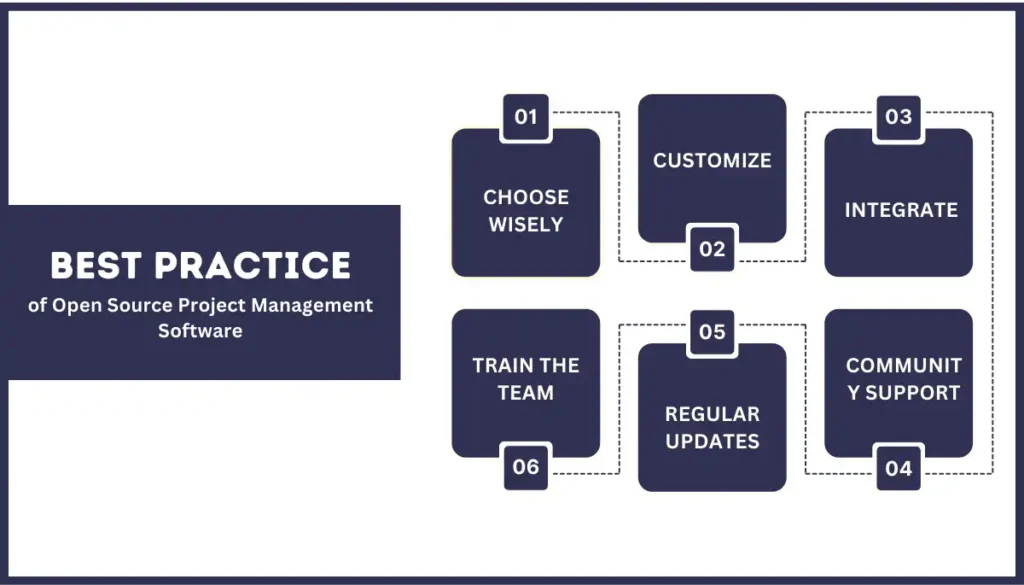
Open-source project management software offers flexibility and cost-effectiveness. But to maximize its benefits, you need to follow some best practices. Here’s how to get the most out of these tools.
- Choose Wisely: Pick a tool that aligns with your project needs and management style.
- Customize: Use the software’s customization features to tailor it to your specific requirements.
- Integrate: Make sure the tool integrates well with other software you’re using, like Google Workspace or Microsoft Office.
- Train the Team: Ensure everyone knows how to use the tool effectively.
- Regular Updates: Keep the software up-to-date to benefit from new features and security patches.
- Community Support: Engage with the software’s community for tips, troubleshooting, and updates.
Following these best practices, you can make the most of open-source project management software.
FAQs
Is It Free to Use?
Mostly, yes. The software itself is usually free, but some features or support services might cost extra.
What Skills Do I Need to Use It?
Basic tech skills are good to start. For advanced customization, some programming knowledge may be required.
What are the Pros and Cons?
Pros include customization and low costs. Cons often involve a steep learning curve and less polished user interfaces.
How Secure is Open Source Project Management Software?
Security varies. Always check updates and community reviews. Some are highly secure, while others may have vulnerabilities.
Is Customer Support Available?
Limited support is common. Some offer paid support for troubleshooting and setup.
Can it Integrate with Other Tools?
It depends on the software. Many offer some form of integration, but it may require manual setup or coding.
Is it Suitable for Large Teams?
Both large and small teams can benefit, but larger teams may face scalability issues.
Final Thoughts
Open-source project management software offers flexibility and cost-effectiveness, making it a strong choice for teams comfortable with customization.
While these platforms often excel in features and adaptability, they can come with a learning curve and limited support. Ultimately, they’re all solid options for those willing to invest time in setup and customization to fit specific project needs.
It depends on the software. Many offer some form of integration, but it may require manual setup or coding.
